Business Strategy for Sainsbury: PESTLE, SWOT, VRIO, Stakeholder and Porter's Five Forces Analysis
VerifiedAdded on 2023/06/13
|21
|6223
|305
AI Summary
This article provides an analysis of the business strategy for Sainsbury, including PESTLE, SWOT, VRIO, stakeholder, and Porter's Five Forces analysis. It covers the internal and external analysis that provides a platform for strategic decision making, critical evaluation of different types of strategic directions available to the organisation, and ways to monitor the chosen strategy/ies for success.
Contribute Materials
Your contribution can guide someone’s learning journey. Share your
documents today.
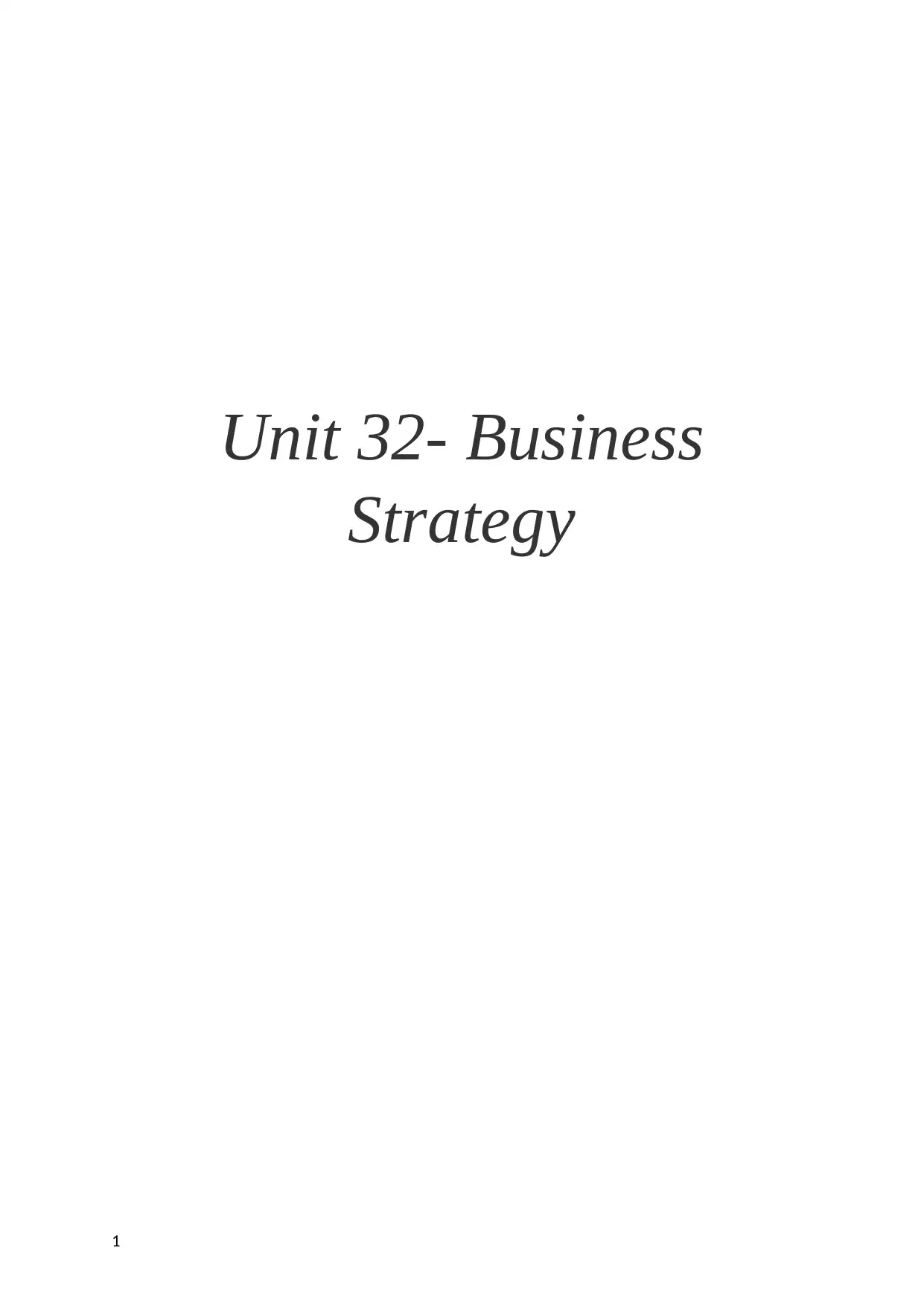
Unit 32- Business
Strategy
1
Strategy
1
Secure Best Marks with AI Grader
Need help grading? Try our AI Grader for instant feedback on your assignments.
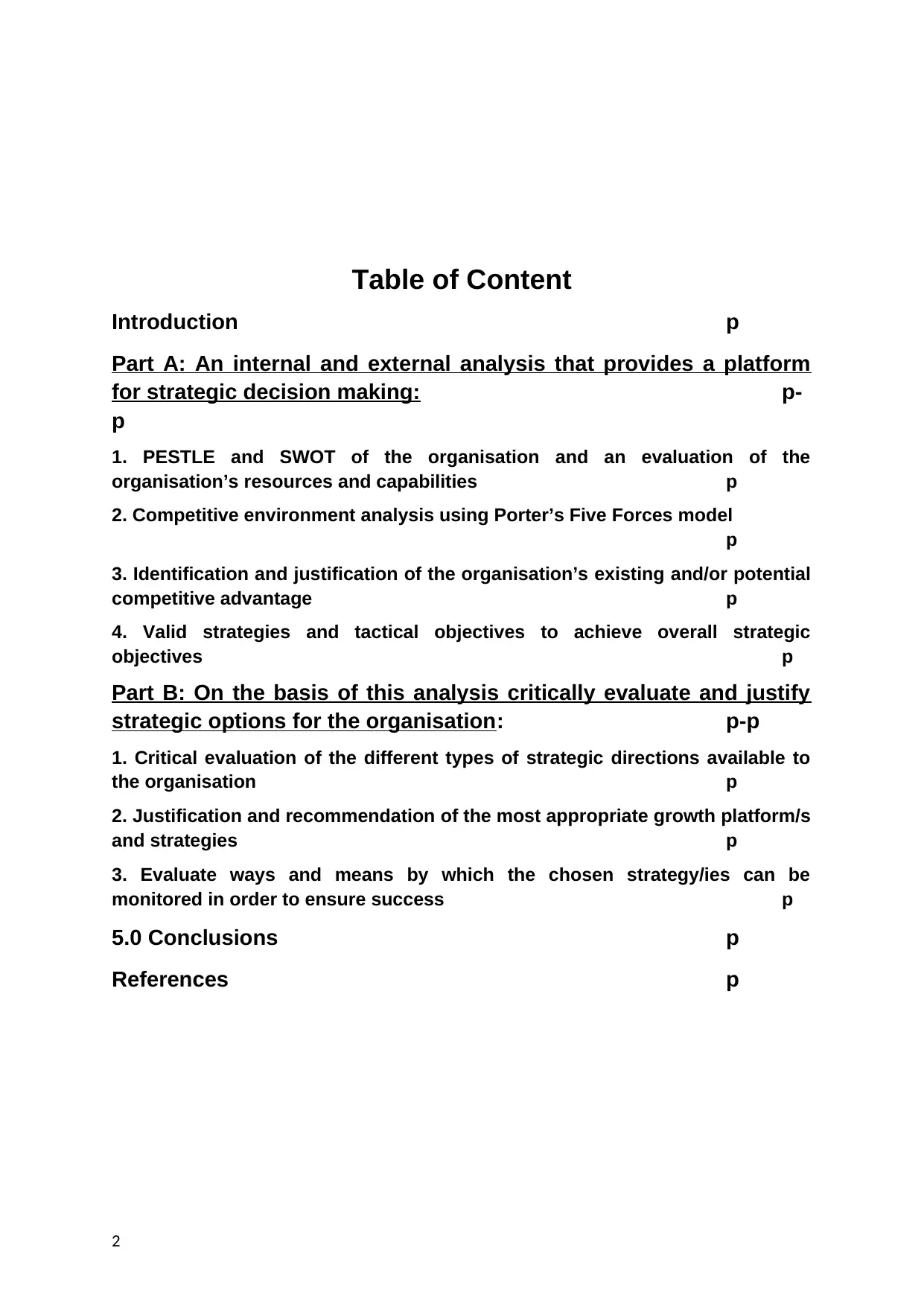
Table of Content
Introduction p
Part A: An internal and external analysis that provides a platform
for strategic decision making: p-
p
1. PESTLE and SWOT of the organisation and an evaluation of the
organisation’s resources and capabilities p
2. Competitive environment analysis using Porter’s Five Forces model
p
3. Identification and justification of the organisation’s existing and/or potential
competitive advantage p
4. Valid strategies and tactical objectives to achieve overall strategic
objectives p
Part B: On the basis of this analysis critically evaluate and justify
strategic options for the organisation: p-p
1. Critical evaluation of the different types of strategic directions available to
the organisation p
2. Justification and recommendation of the most appropriate growth platform/s
and strategies p
3. Evaluate ways and means by which the chosen strategy/ies can be
monitored in order to ensure success p
5.0 Conclusions p
References p
2
Introduction p
Part A: An internal and external analysis that provides a platform
for strategic decision making: p-
p
1. PESTLE and SWOT of the organisation and an evaluation of the
organisation’s resources and capabilities p
2. Competitive environment analysis using Porter’s Five Forces model
p
3. Identification and justification of the organisation’s existing and/or potential
competitive advantage p
4. Valid strategies and tactical objectives to achieve overall strategic
objectives p
Part B: On the basis of this analysis critically evaluate and justify
strategic options for the organisation: p-p
1. Critical evaluation of the different types of strategic directions available to
the organisation p
2. Justification and recommendation of the most appropriate growth platform/s
and strategies p
3. Evaluate ways and means by which the chosen strategy/ies can be
monitored in order to ensure success p
5.0 Conclusions p
References p
2
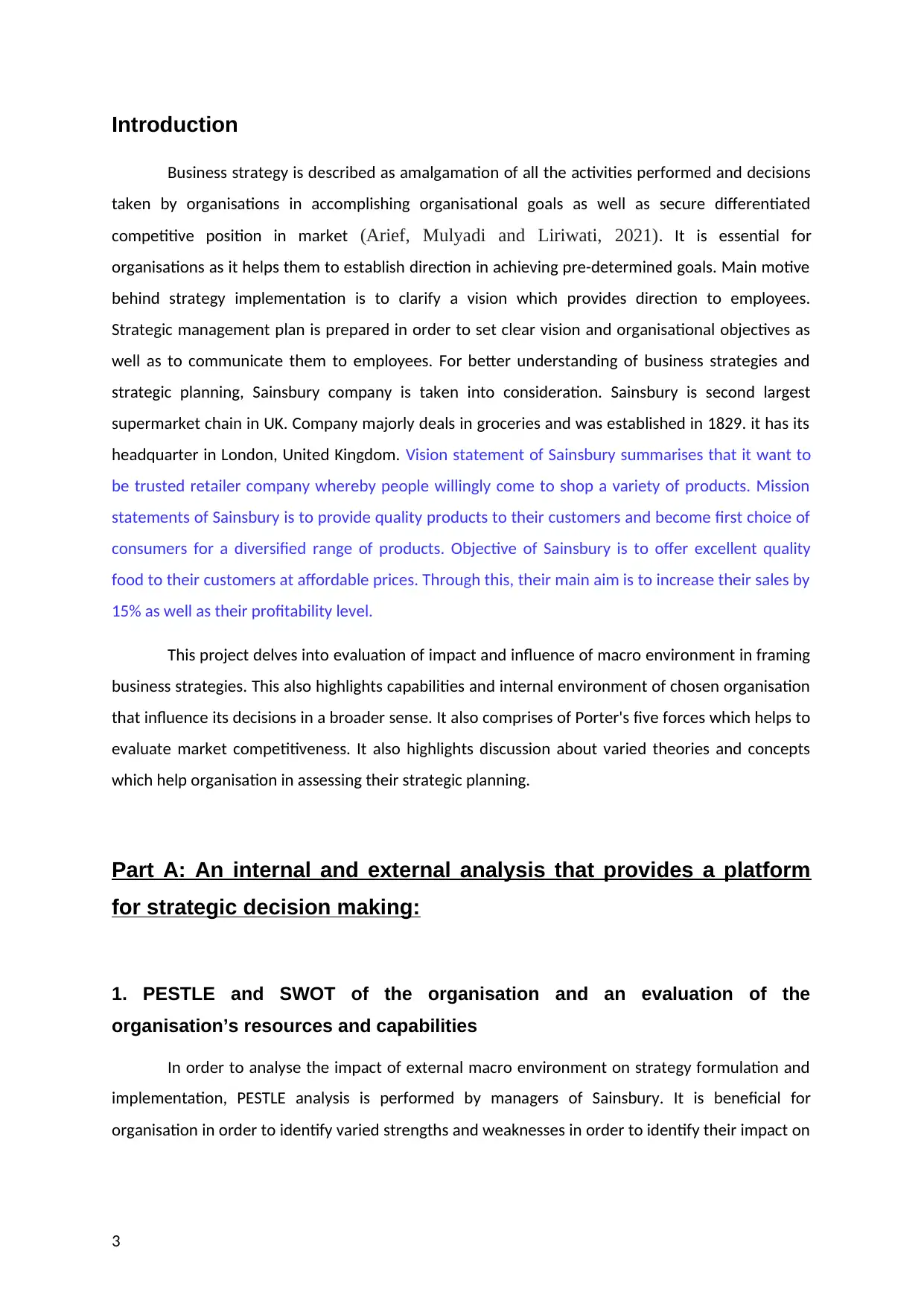
Introduction
Business strategy is described as amalgamation of all the activities performed and decisions
taken by organisations in accomplishing organisational goals as well as secure differentiated
competitive position in market (Arief, Mulyadi and Liriwati, 2021). It is essential for
organisations as it helps them to establish direction in achieving pre-determined goals. Main motive
behind strategy implementation is to clarify a vision which provides direction to employees.
Strategic management plan is prepared in order to set clear vision and organisational objectives as
well as to communicate them to employees. For better understanding of business strategies and
strategic planning, Sainsbury company is taken into consideration. Sainsbury is second largest
supermarket chain in UK. Company majorly deals in groceries and was established in 1829. it has its
headquarter in London, United Kingdom. Vision statement of Sainsbury summarises that it want to
be trusted retailer company whereby people willingly come to shop a variety of products. Mission
statements of Sainsbury is to provide quality products to their customers and become first choice of
consumers for a diversified range of products. Objective of Sainsbury is to offer excellent quality
food to their customers at affordable prices. Through this, their main aim is to increase their sales by
15% as well as their profitability level.
This project delves into evaluation of impact and influence of macro environment in framing
business strategies. This also highlights capabilities and internal environment of chosen organisation
that influence its decisions in a broader sense. It also comprises of Porter's five forces which helps to
evaluate market competitiveness. It also highlights discussion about varied theories and concepts
which help organisation in assessing their strategic planning.
Part A: An internal and external analysis that provides a platform
for strategic decision making:
1. PESTLE and SWOT of the organisation and an evaluation of the
organisation’s resources and capabilities
In order to analyse the impact of external macro environment on strategy formulation and
implementation, PESTLE analysis is performed by managers of Sainsbury. It is beneficial for
organisation in order to identify varied strengths and weaknesses in order to identify their impact on
3
Business strategy is described as amalgamation of all the activities performed and decisions
taken by organisations in accomplishing organisational goals as well as secure differentiated
competitive position in market (Arief, Mulyadi and Liriwati, 2021). It is essential for
organisations as it helps them to establish direction in achieving pre-determined goals. Main motive
behind strategy implementation is to clarify a vision which provides direction to employees.
Strategic management plan is prepared in order to set clear vision and organisational objectives as
well as to communicate them to employees. For better understanding of business strategies and
strategic planning, Sainsbury company is taken into consideration. Sainsbury is second largest
supermarket chain in UK. Company majorly deals in groceries and was established in 1829. it has its
headquarter in London, United Kingdom. Vision statement of Sainsbury summarises that it want to
be trusted retailer company whereby people willingly come to shop a variety of products. Mission
statements of Sainsbury is to provide quality products to their customers and become first choice of
consumers for a diversified range of products. Objective of Sainsbury is to offer excellent quality
food to their customers at affordable prices. Through this, their main aim is to increase their sales by
15% as well as their profitability level.
This project delves into evaluation of impact and influence of macro environment in framing
business strategies. This also highlights capabilities and internal environment of chosen organisation
that influence its decisions in a broader sense. It also comprises of Porter's five forces which helps to
evaluate market competitiveness. It also highlights discussion about varied theories and concepts
which help organisation in assessing their strategic planning.
Part A: An internal and external analysis that provides a platform
for strategic decision making:
1. PESTLE and SWOT of the organisation and an evaluation of the
organisation’s resources and capabilities
In order to analyse the impact of external macro environment on strategy formulation and
implementation, PESTLE analysis is performed by managers of Sainsbury. It is beneficial for
organisation in order to identify varied strengths and weaknesses in order to identify their impact on
3
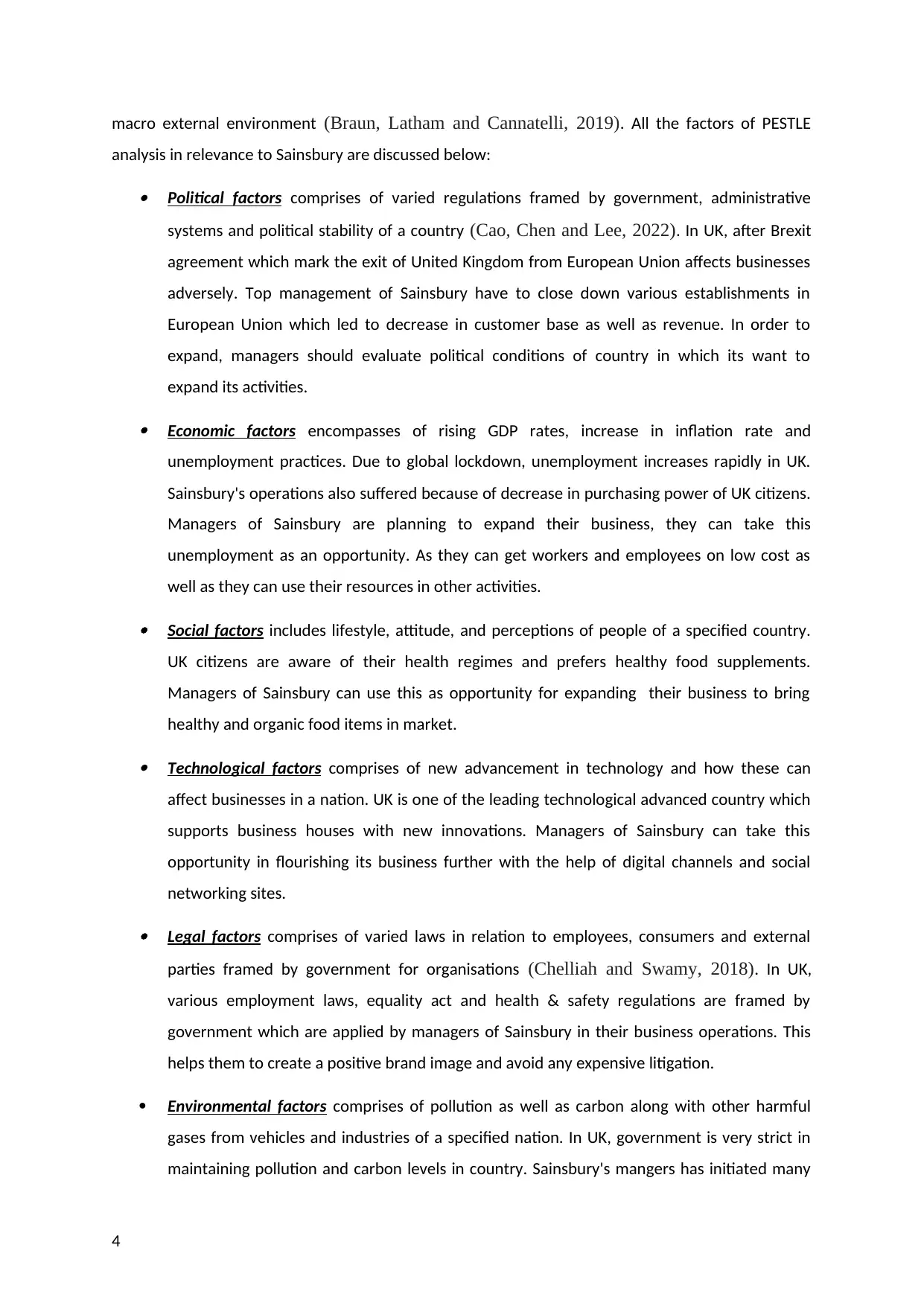
macro external environment (Braun, Latham and Cannatelli, 2019). All the factors of PESTLE
analysis in relevance to Sainsbury are discussed below: Political factors comprises of varied regulations framed by government, administrative
systems and political stability of a country (Cao, Chen and Lee, 2022). In UK, after Brexit
agreement which mark the exit of United Kingdom from European Union affects businesses
adversely. Top management of Sainsbury have to close down various establishments in
European Union which led to decrease in customer base as well as revenue. In order to
expand, managers should evaluate political conditions of country in which its want to
expand its activities. Economic factors encompasses of rising GDP rates, increase in inflation rate and
unemployment practices. Due to global lockdown, unemployment increases rapidly in UK.
Sainsbury's operations also suffered because of decrease in purchasing power of UK citizens.
Managers of Sainsbury are planning to expand their business, they can take this
unemployment as an opportunity. As they can get workers and employees on low cost as
well as they can use their resources in other activities. Social factors includes lifestyle, attitude, and perceptions of people of a specified country.
UK citizens are aware of their health regimes and prefers healthy food supplements.
Managers of Sainsbury can use this as opportunity for expanding their business to bring
healthy and organic food items in market. Technological factors comprises of new advancement in technology and how these can
affect businesses in a nation. UK is one of the leading technological advanced country which
supports business houses with new innovations. Managers of Sainsbury can take this
opportunity in flourishing its business further with the help of digital channels and social
networking sites. Legal factors comprises of varied laws in relation to employees, consumers and external
parties framed by government for organisations (Chelliah and Swamy, 2018). In UK,
various employment laws, equality act and health & safety regulations are framed by
government which are applied by managers of Sainsbury in their business operations. This
helps them to create a positive brand image and avoid any expensive litigation.
Environmental factors comprises of pollution as well as carbon along with other harmful
gases from vehicles and industries of a specified nation. In UK, government is very strict in
maintaining pollution and carbon levels in country. Sainsbury's mangers has initiated many
4
analysis in relevance to Sainsbury are discussed below: Political factors comprises of varied regulations framed by government, administrative
systems and political stability of a country (Cao, Chen and Lee, 2022). In UK, after Brexit
agreement which mark the exit of United Kingdom from European Union affects businesses
adversely. Top management of Sainsbury have to close down various establishments in
European Union which led to decrease in customer base as well as revenue. In order to
expand, managers should evaluate political conditions of country in which its want to
expand its activities. Economic factors encompasses of rising GDP rates, increase in inflation rate and
unemployment practices. Due to global lockdown, unemployment increases rapidly in UK.
Sainsbury's operations also suffered because of decrease in purchasing power of UK citizens.
Managers of Sainsbury are planning to expand their business, they can take this
unemployment as an opportunity. As they can get workers and employees on low cost as
well as they can use their resources in other activities. Social factors includes lifestyle, attitude, and perceptions of people of a specified country.
UK citizens are aware of their health regimes and prefers healthy food supplements.
Managers of Sainsbury can use this as opportunity for expanding their business to bring
healthy and organic food items in market. Technological factors comprises of new advancement in technology and how these can
affect businesses in a nation. UK is one of the leading technological advanced country which
supports business houses with new innovations. Managers of Sainsbury can take this
opportunity in flourishing its business further with the help of digital channels and social
networking sites. Legal factors comprises of varied laws in relation to employees, consumers and external
parties framed by government for organisations (Chelliah and Swamy, 2018). In UK,
various employment laws, equality act and health & safety regulations are framed by
government which are applied by managers of Sainsbury in their business operations. This
helps them to create a positive brand image and avoid any expensive litigation.
Environmental factors comprises of pollution as well as carbon along with other harmful
gases from vehicles and industries of a specified nation. In UK, government is very strict in
maintaining pollution and carbon levels in country. Sainsbury's mangers has initiated many
4
Secure Best Marks with AI Grader
Need help grading? Try our AI Grader for instant feedback on your assignments.
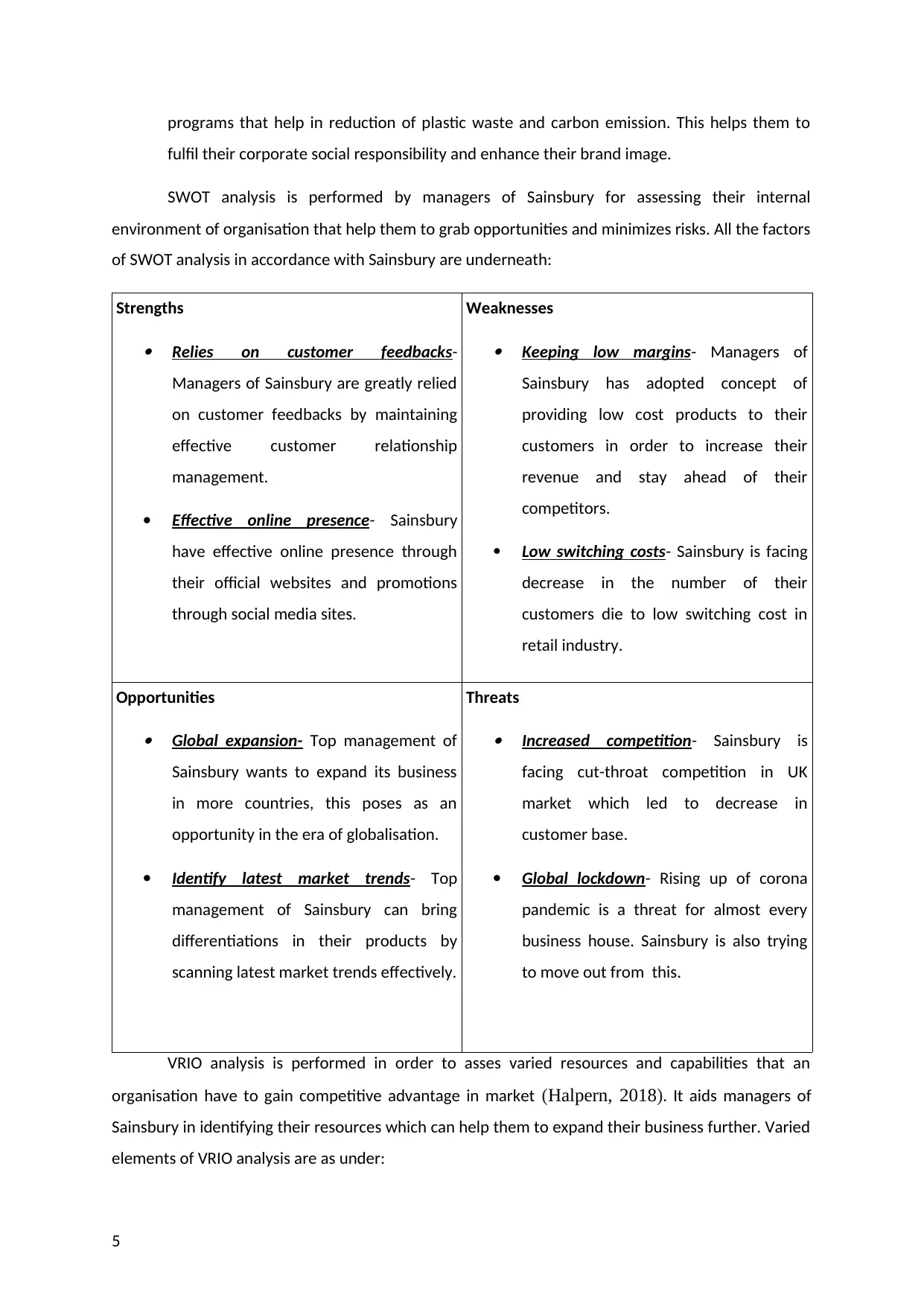
programs that help in reduction of plastic waste and carbon emission. This helps them to
fulfil their corporate social responsibility and enhance their brand image.
SWOT analysis is performed by managers of Sainsbury for assessing their internal
environment of organisation that help them to grab opportunities and minimizes risks. All the factors
of SWOT analysis in accordance with Sainsbury are underneath:
Strengths Relies on customer feedbacks-
Managers of Sainsbury are greatly relied
on customer feedbacks by maintaining
effective customer relationship
management.
Effective online presence- Sainsbury
have effective online presence through
their official websites and promotions
through social media sites.
Weaknesses
Keeping low margins- Managers of
Sainsbury has adopted concept of
providing low cost products to their
customers in order to increase their
revenue and stay ahead of their
competitors.
Low switching costs- Sainsbury is facing
decrease in the number of their
customers die to low switching cost in
retail industry.
Opportunities Global expansion- Top management of
Sainsbury wants to expand its business
in more countries, this poses as an
opportunity in the era of globalisation.
Identify latest market trends- Top
management of Sainsbury can bring
differentiations in their products by
scanning latest market trends effectively.
Threats
Increased competition- Sainsbury is
facing cut-throat competition in UK
market which led to decrease in
customer base.
Global lockdown- Rising up of corona
pandemic is a threat for almost every
business house. Sainsbury is also trying
to move out from this.
VRIO analysis is performed in order to asses varied resources and capabilities that an
organisation have to gain competitive advantage in market (Halpern, 2018). It aids managers of
Sainsbury in identifying their resources which can help them to expand their business further. Varied
elements of VRIO analysis are as under:
5
fulfil their corporate social responsibility and enhance their brand image.
SWOT analysis is performed by managers of Sainsbury for assessing their internal
environment of organisation that help them to grab opportunities and minimizes risks. All the factors
of SWOT analysis in accordance with Sainsbury are underneath:
Strengths Relies on customer feedbacks-
Managers of Sainsbury are greatly relied
on customer feedbacks by maintaining
effective customer relationship
management.
Effective online presence- Sainsbury
have effective online presence through
their official websites and promotions
through social media sites.
Weaknesses
Keeping low margins- Managers of
Sainsbury has adopted concept of
providing low cost products to their
customers in order to increase their
revenue and stay ahead of their
competitors.
Low switching costs- Sainsbury is facing
decrease in the number of their
customers die to low switching cost in
retail industry.
Opportunities Global expansion- Top management of
Sainsbury wants to expand its business
in more countries, this poses as an
opportunity in the era of globalisation.
Identify latest market trends- Top
management of Sainsbury can bring
differentiations in their products by
scanning latest market trends effectively.
Threats
Increased competition- Sainsbury is
facing cut-throat competition in UK
market which led to decrease in
customer base.
Global lockdown- Rising up of corona
pandemic is a threat for almost every
business house. Sainsbury is also trying
to move out from this.
VRIO analysis is performed in order to asses varied resources and capabilities that an
organisation have to gain competitive advantage in market (Halpern, 2018). It aids managers of
Sainsbury in identifying their resources which can help them to expand their business further. Varied
elements of VRIO analysis are as under:
5
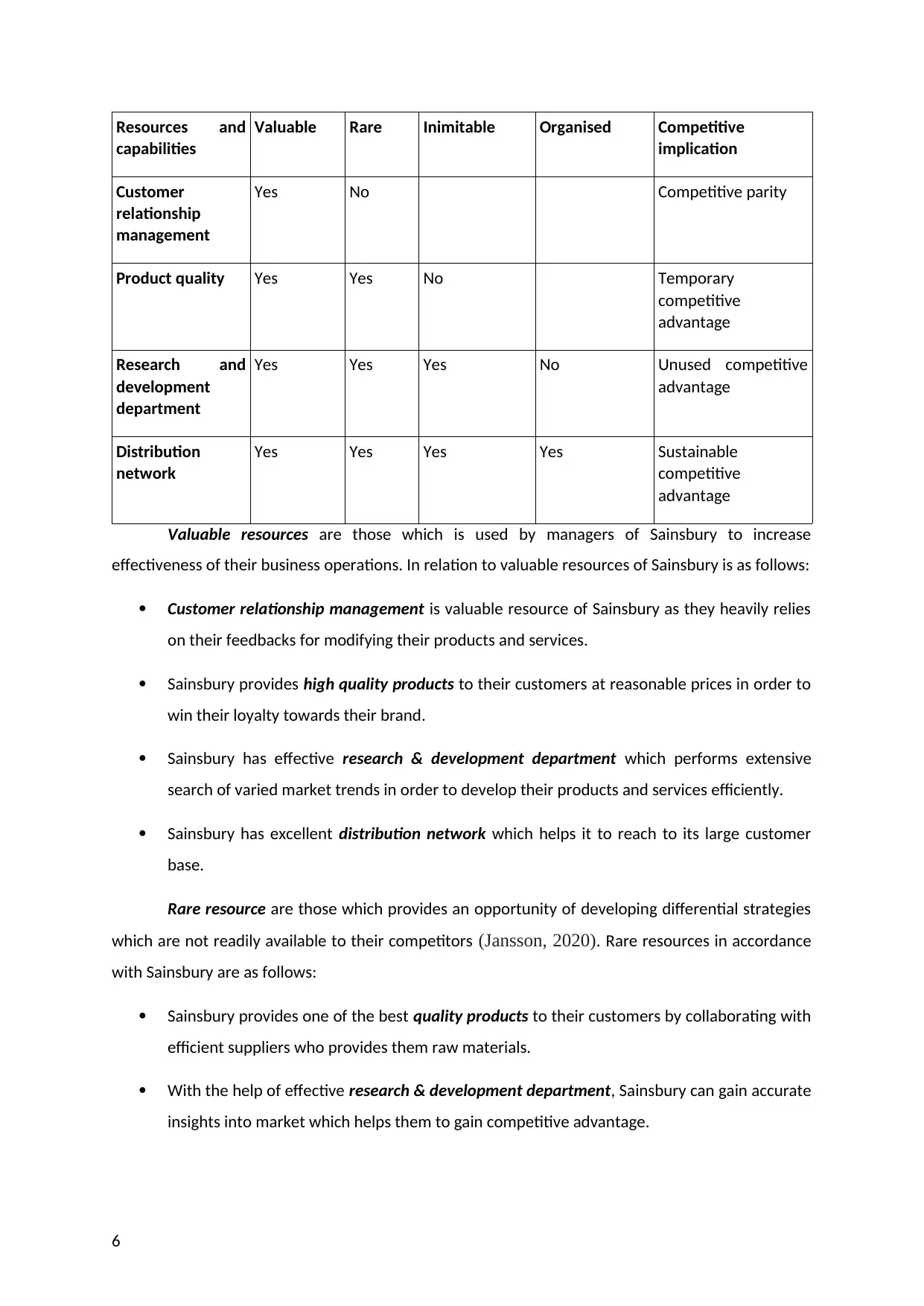
Resources and
capabilities
Valuable Rare Inimitable Organised Competitive
implication
Customer
relationship
management
Yes No Competitive parity
Product quality Yes Yes No Temporary
competitive
advantage
Research and
development
department
Yes Yes Yes No Unused competitive
advantage
Distribution
network
Yes Yes Yes Yes Sustainable
competitive
advantage
Valuable resources are those which is used by managers of Sainsbury to increase
effectiveness of their business operations. In relation to valuable resources of Sainsbury is as follows:
Customer relationship management is valuable resource of Sainsbury as they heavily relies
on their feedbacks for modifying their products and services.
Sainsbury provides high quality products to their customers at reasonable prices in order to
win their loyalty towards their brand.
Sainsbury has effective research & development department which performs extensive
search of varied market trends in order to develop their products and services efficiently.
Sainsbury has excellent distribution network which helps it to reach to its large customer
base.
Rare resource are those which provides an opportunity of developing differential strategies
which are not readily available to their competitors (Jansson, 2020). Rare resources in accordance
with Sainsbury are as follows:
Sainsbury provides one of the best quality products to their customers by collaborating with
efficient suppliers who provides them raw materials.
With the help of effective research & development department, Sainsbury can gain accurate
insights into market which helps them to gain competitive advantage.
6
capabilities
Valuable Rare Inimitable Organised Competitive
implication
Customer
relationship
management
Yes No Competitive parity
Product quality Yes Yes No Temporary
competitive
advantage
Research and
development
department
Yes Yes Yes No Unused competitive
advantage
Distribution
network
Yes Yes Yes Yes Sustainable
competitive
advantage
Valuable resources are those which is used by managers of Sainsbury to increase
effectiveness of their business operations. In relation to valuable resources of Sainsbury is as follows:
Customer relationship management is valuable resource of Sainsbury as they heavily relies
on their feedbacks for modifying their products and services.
Sainsbury provides high quality products to their customers at reasonable prices in order to
win their loyalty towards their brand.
Sainsbury has effective research & development department which performs extensive
search of varied market trends in order to develop their products and services efficiently.
Sainsbury has excellent distribution network which helps it to reach to its large customer
base.
Rare resource are those which provides an opportunity of developing differential strategies
which are not readily available to their competitors (Jansson, 2020). Rare resources in accordance
with Sainsbury are as follows:
Sainsbury provides one of the best quality products to their customers by collaborating with
efficient suppliers who provides them raw materials.
With the help of effective research & development department, Sainsbury can gain accurate
insights into market which helps them to gain competitive advantage.
6
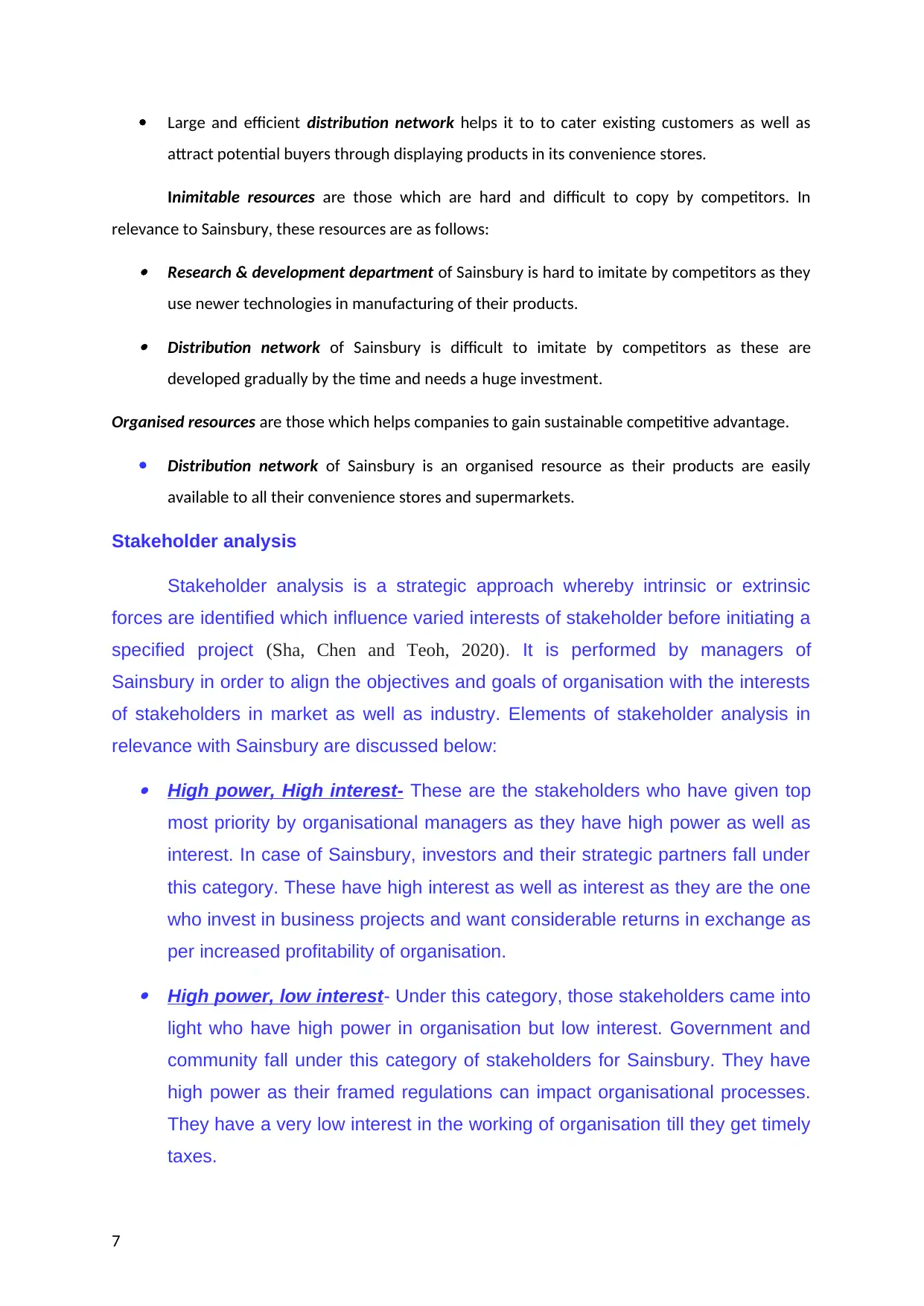
Large and efficient distribution network helps it to to cater existing customers as well as
attract potential buyers through displaying products in its convenience stores.
Inimitable resources are those which are hard and difficult to copy by competitors. In
relevance to Sainsbury, these resources are as follows: Research & development department of Sainsbury is hard to imitate by competitors as they
use newer technologies in manufacturing of their products. Distribution network of Sainsbury is difficult to imitate by competitors as these are
developed gradually by the time and needs a huge investment.
Organised resources are those which helps companies to gain sustainable competitive advantage.
Distribution network of Sainsbury is an organised resource as their products are easily
available to all their convenience stores and supermarkets.
Stakeholder analysis
Stakeholder analysis is a strategic approach whereby intrinsic or extrinsic
forces are identified which influence varied interests of stakeholder before initiating a
specified project (Sha, Chen and Teoh, 2020). It is performed by managers of
Sainsbury in order to align the objectives and goals of organisation with the interests
of stakeholders in market as well as industry. Elements of stakeholder analysis in
relevance with Sainsbury are discussed below: High power, High interest- These are the stakeholders who have given top
most priority by organisational managers as they have high power as well as
interest. In case of Sainsbury, investors and their strategic partners fall under
this category. These have high interest as well as interest as they are the one
who invest in business projects and want considerable returns in exchange as
per increased profitability of organisation. High power, low interest- Under this category, those stakeholders came into
light who have high power in organisation but low interest. Government and
community fall under this category of stakeholders for Sainsbury. They have
high power as their framed regulations can impact organisational processes.
They have a very low interest in the working of organisation till they get timely
taxes.
7
attract potential buyers through displaying products in its convenience stores.
Inimitable resources are those which are hard and difficult to copy by competitors. In
relevance to Sainsbury, these resources are as follows: Research & development department of Sainsbury is hard to imitate by competitors as they
use newer technologies in manufacturing of their products. Distribution network of Sainsbury is difficult to imitate by competitors as these are
developed gradually by the time and needs a huge investment.
Organised resources are those which helps companies to gain sustainable competitive advantage.
Distribution network of Sainsbury is an organised resource as their products are easily
available to all their convenience stores and supermarkets.
Stakeholder analysis
Stakeholder analysis is a strategic approach whereby intrinsic or extrinsic
forces are identified which influence varied interests of stakeholder before initiating a
specified project (Sha, Chen and Teoh, 2020). It is performed by managers of
Sainsbury in order to align the objectives and goals of organisation with the interests
of stakeholders in market as well as industry. Elements of stakeholder analysis in
relevance with Sainsbury are discussed below: High power, High interest- These are the stakeholders who have given top
most priority by organisational managers as they have high power as well as
interest. In case of Sainsbury, investors and their strategic partners fall under
this category. These have high interest as well as interest as they are the one
who invest in business projects and want considerable returns in exchange as
per increased profitability of organisation. High power, low interest- Under this category, those stakeholders came into
light who have high power in organisation but low interest. Government and
community fall under this category of stakeholders for Sainsbury. They have
high power as their framed regulations can impact organisational processes.
They have a very low interest in the working of organisation till they get timely
taxes.
7
Paraphrase This Document
Need a fresh take? Get an instant paraphrase of this document with our AI Paraphraser

Low power, high interest- These type of stakeholders have low power in
organisation but high interest in workings of establishment (Henriques and Et.
Al., 2019). Employees of Sainsbury are taken into consideration for this
category. As they are not able to give any suggestion to decision-makers but
get their salaries from them this delves their interest in processes of
organisation.
Low power, low interest- These are the stakeholders who need to be
informed about organisation workings as they have low interest as well as
power. In relevance to Sainsbury, customers are come under this category as
they have low or no interest in workings of organisation as switching power is
high in retail industry.
2. Competitive environment analysis using Porter’s Five Forces model
Porter's five forces is a process by which a company examines as well as identify its strengths
and weaknesses by evaluating several forces (Kabongo, 2020). It is applied by companies to
anticipate the threats in future due to dynamic market. Porter identifies the five essential forces that
shapes companies in any industry. All the factors of porter's five forces in relevance to Sainsbury are
described below: Competitive rivalry- First force impacting business is the competition that states number of
competitors and degree of competition in market. It suggests bigger the competition, the
lower the chances of profits. In retail industry the intensity of rivalry is very high due to
several number of companies dealing in same commodities. Sainsbury is engaged in an high
competition with its rivals like Tesco and ASDA. Competition is heavily governed by Tesco
who covers a large market in retail industry. Both the brands are engaged in various
initiatives to broaden their share in market which turns out to be huge threat to Sainsbury
growth. Bargaining power of Suppliers- Next force describes that suppliers have the power to
increase the cost of inputs for an organisation. Suppliers can put burden on companies by
lowering the quality of products, decreasing product availability or increasing prices of
materials. Immense supplier power can drive the competition in the retail industry and
diminish the level of profits for company. This force has comparatively low impact on
Sainsbury as it is not affected by the bargaining power of suppliers because it deals with
8
organisation but high interest in workings of establishment (Henriques and Et.
Al., 2019). Employees of Sainsbury are taken into consideration for this
category. As they are not able to give any suggestion to decision-makers but
get their salaries from them this delves their interest in processes of
organisation.
Low power, low interest- These are the stakeholders who need to be
informed about organisation workings as they have low interest as well as
power. In relevance to Sainsbury, customers are come under this category as
they have low or no interest in workings of organisation as switching power is
high in retail industry.
2. Competitive environment analysis using Porter’s Five Forces model
Porter's five forces is a process by which a company examines as well as identify its strengths
and weaknesses by evaluating several forces (Kabongo, 2020). It is applied by companies to
anticipate the threats in future due to dynamic market. Porter identifies the five essential forces that
shapes companies in any industry. All the factors of porter's five forces in relevance to Sainsbury are
described below: Competitive rivalry- First force impacting business is the competition that states number of
competitors and degree of competition in market. It suggests bigger the competition, the
lower the chances of profits. In retail industry the intensity of rivalry is very high due to
several number of companies dealing in same commodities. Sainsbury is engaged in an high
competition with its rivals like Tesco and ASDA. Competition is heavily governed by Tesco
who covers a large market in retail industry. Both the brands are engaged in various
initiatives to broaden their share in market which turns out to be huge threat to Sainsbury
growth. Bargaining power of Suppliers- Next force describes that suppliers have the power to
increase the cost of inputs for an organisation. Suppliers can put burden on companies by
lowering the quality of products, decreasing product availability or increasing prices of
materials. Immense supplier power can drive the competition in the retail industry and
diminish the level of profits for company. This force has comparatively low impact on
Sainsbury as it is not affected by the bargaining power of suppliers because it deals with
8
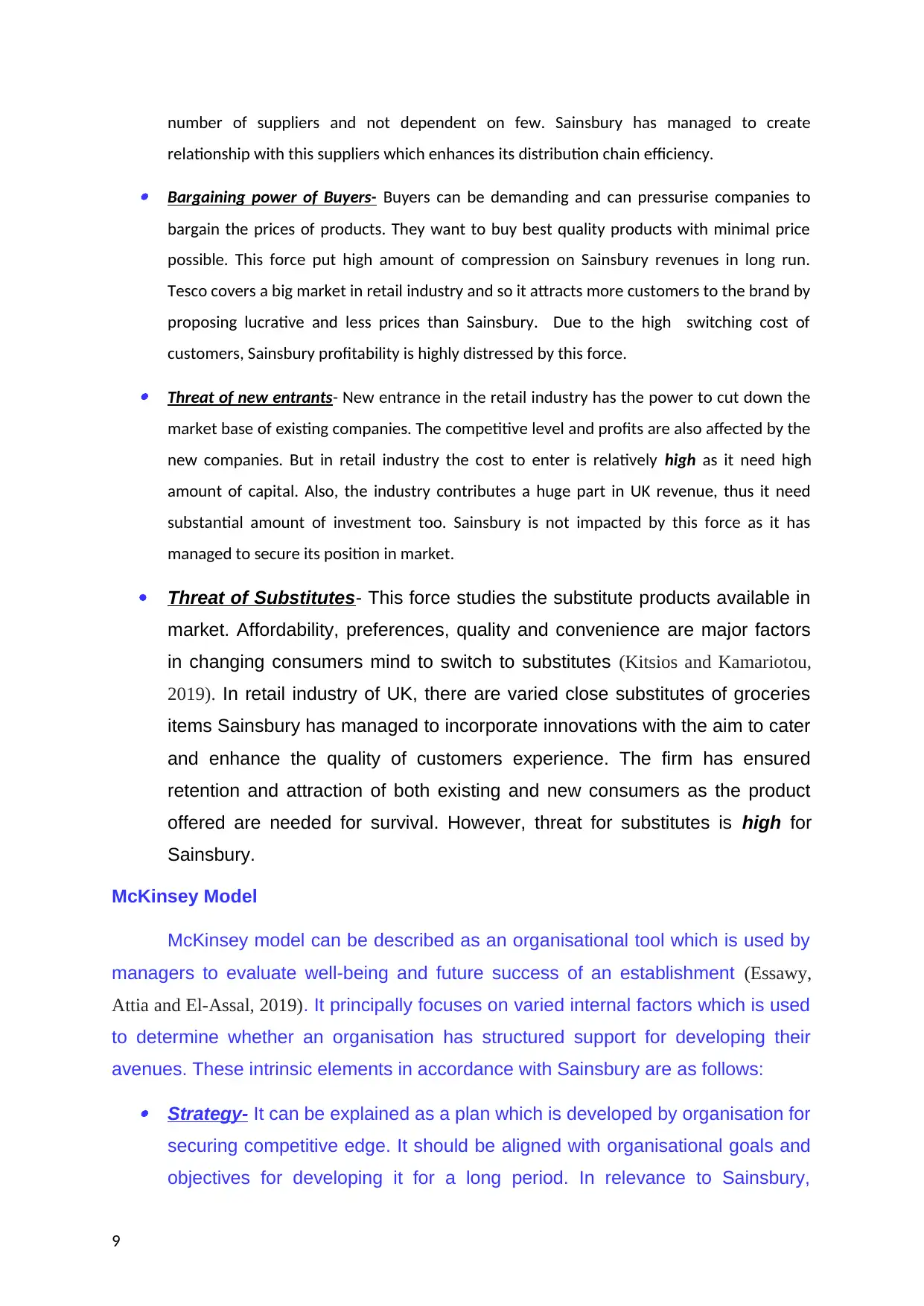
number of suppliers and not dependent on few. Sainsbury has managed to create
relationship with this suppliers which enhances its distribution chain efficiency. Bargaining power of Buyers- Buyers can be demanding and can pressurise companies to
bargain the prices of products. They want to buy best quality products with minimal price
possible. This force put high amount of compression on Sainsbury revenues in long run.
Tesco covers a big market in retail industry and so it attracts more customers to the brand by
proposing lucrative and less prices than Sainsbury. Due to the high switching cost of
customers, Sainsbury profitability is highly distressed by this force. Threat of new entrants- New entrance in the retail industry has the power to cut down the
market base of existing companies. The competitive level and profits are also affected by the
new companies. But in retail industry the cost to enter is relatively high as it need high
amount of capital. Also, the industry contributes a huge part in UK revenue, thus it need
substantial amount of investment too. Sainsbury is not impacted by this force as it has
managed to secure its position in market.
Threat of Substitutes- This force studies the substitute products available in
market. Affordability, preferences, quality and convenience are major factors
in changing consumers mind to switch to substitutes (Kitsios and Kamariotou,
2019). In retail industry of UK, there are varied close substitutes of groceries
items Sainsbury has managed to incorporate innovations with the aim to cater
and enhance the quality of customers experience. The firm has ensured
retention and attraction of both existing and new consumers as the product
offered are needed for survival. However, threat for substitutes is high for
Sainsbury.
McKinsey Model
McKinsey model can be described as an organisational tool which is used by
managers to evaluate well-being and future success of an establishment (Essawy,
Attia and El-Assal, 2019). It principally focuses on varied internal factors which is used
to determine whether an organisation has structured support for developing their
avenues. These intrinsic elements in accordance with Sainsbury are as follows: Strategy- It can be explained as a plan which is developed by organisation for
securing competitive edge. It should be aligned with organisational goals and
objectives for developing it for a long period. In relevance to Sainsbury,
9
relationship with this suppliers which enhances its distribution chain efficiency. Bargaining power of Buyers- Buyers can be demanding and can pressurise companies to
bargain the prices of products. They want to buy best quality products with minimal price
possible. This force put high amount of compression on Sainsbury revenues in long run.
Tesco covers a big market in retail industry and so it attracts more customers to the brand by
proposing lucrative and less prices than Sainsbury. Due to the high switching cost of
customers, Sainsbury profitability is highly distressed by this force. Threat of new entrants- New entrance in the retail industry has the power to cut down the
market base of existing companies. The competitive level and profits are also affected by the
new companies. But in retail industry the cost to enter is relatively high as it need high
amount of capital. Also, the industry contributes a huge part in UK revenue, thus it need
substantial amount of investment too. Sainsbury is not impacted by this force as it has
managed to secure its position in market.
Threat of Substitutes- This force studies the substitute products available in
market. Affordability, preferences, quality and convenience are major factors
in changing consumers mind to switch to substitutes (Kitsios and Kamariotou,
2019). In retail industry of UK, there are varied close substitutes of groceries
items Sainsbury has managed to incorporate innovations with the aim to cater
and enhance the quality of customers experience. The firm has ensured
retention and attraction of both existing and new consumers as the product
offered are needed for survival. However, threat for substitutes is high for
Sainsbury.
McKinsey Model
McKinsey model can be described as an organisational tool which is used by
managers to evaluate well-being and future success of an establishment (Essawy,
Attia and El-Assal, 2019). It principally focuses on varied internal factors which is used
to determine whether an organisation has structured support for developing their
avenues. These intrinsic elements in accordance with Sainsbury are as follows: Strategy- It can be explained as a plan which is developed by organisation for
securing competitive edge. It should be aligned with organisational goals and
objectives for developing it for a long period. In relevance to Sainsbury,
9
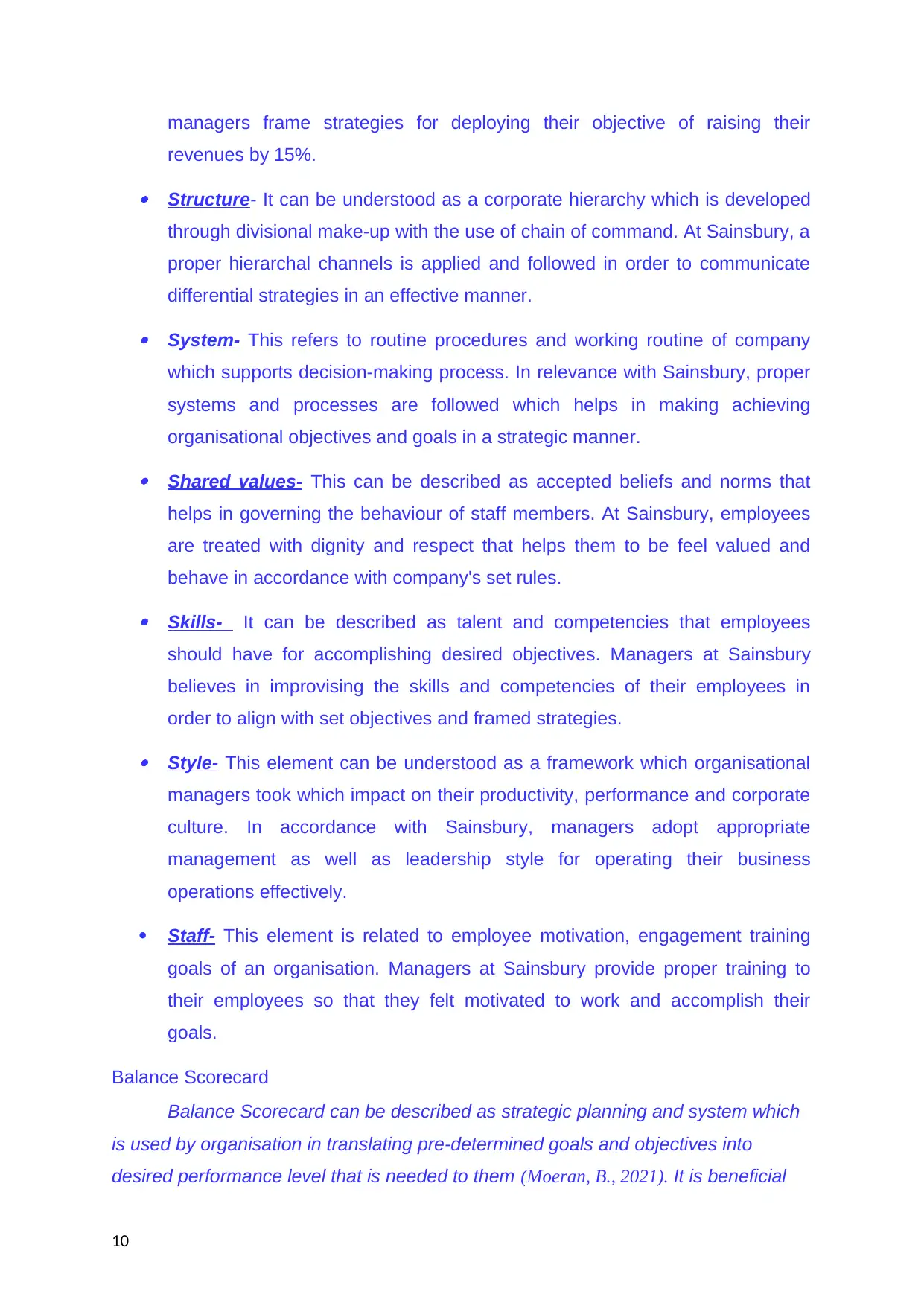
managers frame strategies for deploying their objective of raising their
revenues by 15%. Structure- It can be understood as a corporate hierarchy which is developed
through divisional make-up with the use of chain of command. At Sainsbury, a
proper hierarchal channels is applied and followed in order to communicate
differential strategies in an effective manner. System- This refers to routine procedures and working routine of company
which supports decision-making process. In relevance with Sainsbury, proper
systems and processes are followed which helps in making achieving
organisational objectives and goals in a strategic manner. Shared values- This can be described as accepted beliefs and norms that
helps in governing the behaviour of staff members. At Sainsbury, employees
are treated with dignity and respect that helps them to be feel valued and
behave in accordance with company's set rules. Skills- It can be described as talent and competencies that employees
should have for accomplishing desired objectives. Managers at Sainsbury
believes in improvising the skills and competencies of their employees in
order to align with set objectives and framed strategies. Style- This element can be understood as a framework which organisational
managers took which impact on their productivity, performance and corporate
culture. In accordance with Sainsbury, managers adopt appropriate
management as well as leadership style for operating their business
operations effectively.
Staff- This element is related to employee motivation, engagement training
goals of an organisation. Managers at Sainsbury provide proper training to
their employees so that they felt motivated to work and accomplish their
goals.
Balance Scorecard
Balance Scorecard can be described as strategic planning and system which
is used by organisation in translating pre-determined goals and objectives into
desired performance level that is needed to them (Moeran, B., 2021). It is beneficial
10
revenues by 15%. Structure- It can be understood as a corporate hierarchy which is developed
through divisional make-up with the use of chain of command. At Sainsbury, a
proper hierarchal channels is applied and followed in order to communicate
differential strategies in an effective manner. System- This refers to routine procedures and working routine of company
which supports decision-making process. In relevance with Sainsbury, proper
systems and processes are followed which helps in making achieving
organisational objectives and goals in a strategic manner. Shared values- This can be described as accepted beliefs and norms that
helps in governing the behaviour of staff members. At Sainsbury, employees
are treated with dignity and respect that helps them to be feel valued and
behave in accordance with company's set rules. Skills- It can be described as talent and competencies that employees
should have for accomplishing desired objectives. Managers at Sainsbury
believes in improvising the skills and competencies of their employees in
order to align with set objectives and framed strategies. Style- This element can be understood as a framework which organisational
managers took which impact on their productivity, performance and corporate
culture. In accordance with Sainsbury, managers adopt appropriate
management as well as leadership style for operating their business
operations effectively.
Staff- This element is related to employee motivation, engagement training
goals of an organisation. Managers at Sainsbury provide proper training to
their employees so that they felt motivated to work and accomplish their
goals.
Balance Scorecard
Balance Scorecard can be described as strategic planning and system which
is used by organisation in translating pre-determined goals and objectives into
desired performance level that is needed to them (Moeran, B., 2021). It is beneficial
10
Secure Best Marks with AI Grader
Need help grading? Try our AI Grader for instant feedback on your assignments.
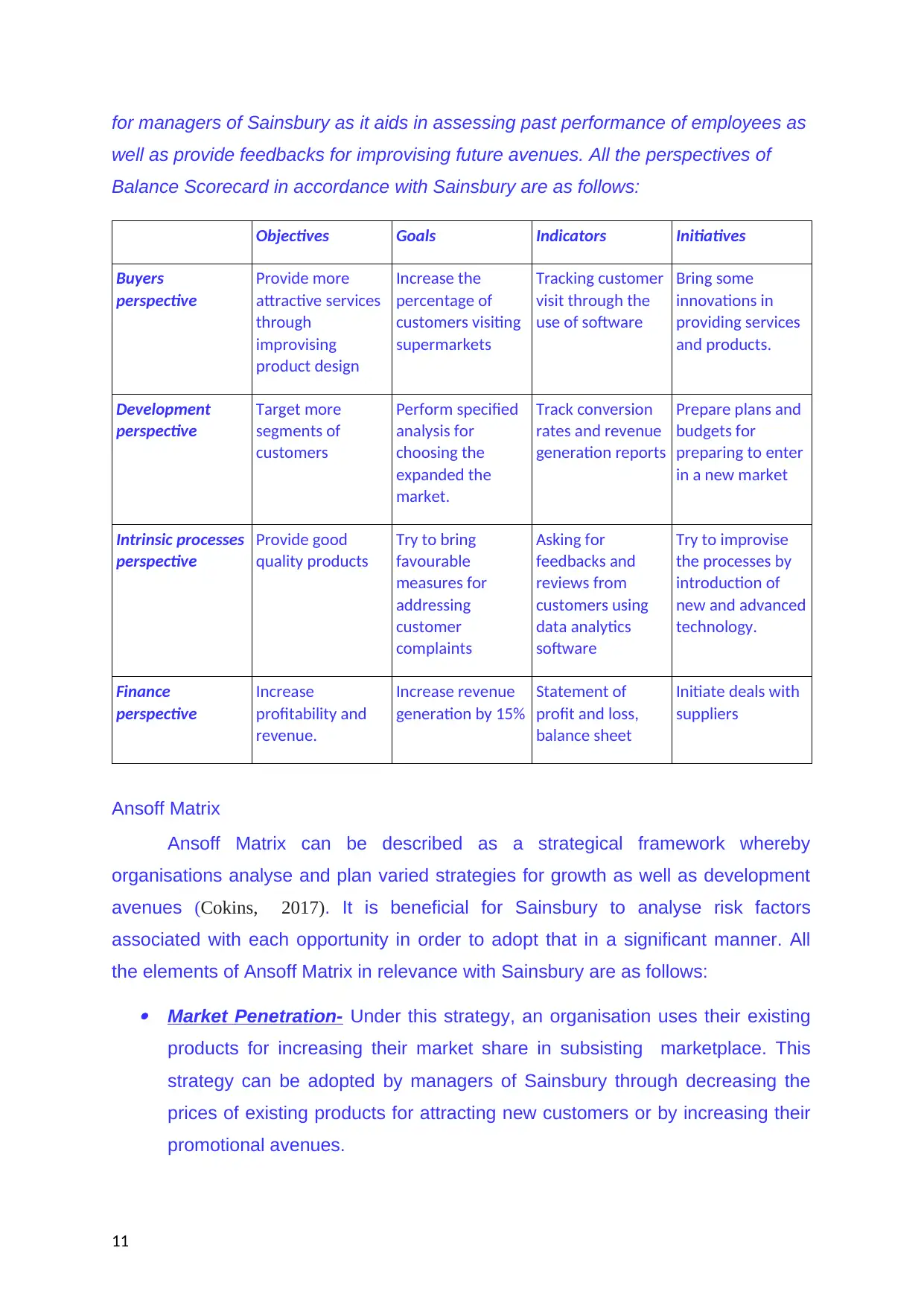
for managers of Sainsbury as it aids in assessing past performance of employees as
well as provide feedbacks for improvising future avenues. All the perspectives of
Balance Scorecard in accordance with Sainsbury are as follows:
Objectives Goals Indicators Initiatives
Buyers
perspective
Provide more
attractive services
through
improvising
product design
Increase the
percentage of
customers visiting
supermarkets
Tracking customer
visit through the
use of software
Bring some
innovations in
providing services
and products.
Development
perspective
Target more
segments of
customers
Perform specified
analysis for
choosing the
expanded the
market.
Track conversion
rates and revenue
generation reports
Prepare plans and
budgets for
preparing to enter
in a new market
Intrinsic processes
perspective
Provide good
quality products
Try to bring
favourable
measures for
addressing
customer
complaints
Asking for
feedbacks and
reviews from
customers using
data analytics
software
Try to improvise
the processes by
introduction of
new and advanced
technology.
Finance
perspective
Increase
profitability and
revenue.
Increase revenue
generation by 15%
Statement of
profit and loss,
balance sheet
Initiate deals with
suppliers
Ansoff Matrix
Ansoff Matrix can be described as a strategical framework whereby
organisations analyse and plan varied strategies for growth as well as development
avenues (Cokins, 2017). It is beneficial for Sainsbury to analyse risk factors
associated with each opportunity in order to adopt that in a significant manner. All
the elements of Ansoff Matrix in relevance with Sainsbury are as follows: Market Penetration- Under this strategy, an organisation uses their existing
products for increasing their market share in subsisting marketplace. This
strategy can be adopted by managers of Sainsbury through decreasing the
prices of existing products for attracting new customers or by increasing their
promotional avenues.
11
well as provide feedbacks for improvising future avenues. All the perspectives of
Balance Scorecard in accordance with Sainsbury are as follows:
Objectives Goals Indicators Initiatives
Buyers
perspective
Provide more
attractive services
through
improvising
product design
Increase the
percentage of
customers visiting
supermarkets
Tracking customer
visit through the
use of software
Bring some
innovations in
providing services
and products.
Development
perspective
Target more
segments of
customers
Perform specified
analysis for
choosing the
expanded the
market.
Track conversion
rates and revenue
generation reports
Prepare plans and
budgets for
preparing to enter
in a new market
Intrinsic processes
perspective
Provide good
quality products
Try to bring
favourable
measures for
addressing
customer
complaints
Asking for
feedbacks and
reviews from
customers using
data analytics
software
Try to improvise
the processes by
introduction of
new and advanced
technology.
Finance
perspective
Increase
profitability and
revenue.
Increase revenue
generation by 15%
Statement of
profit and loss,
balance sheet
Initiate deals with
suppliers
Ansoff Matrix
Ansoff Matrix can be described as a strategical framework whereby
organisations analyse and plan varied strategies for growth as well as development
avenues (Cokins, 2017). It is beneficial for Sainsbury to analyse risk factors
associated with each opportunity in order to adopt that in a significant manner. All
the elements of Ansoff Matrix in relevance with Sainsbury are as follows: Market Penetration- Under this strategy, an organisation uses their existing
products for increasing their market share in subsisting marketplace. This
strategy can be adopted by managers of Sainsbury through decreasing the
prices of existing products for attracting new customers or by increasing their
promotional avenues.
11

Product Development- Under this strategy, an organisation develops a new
product in subsisting market which help them to gain competitive advantage.
This strategy can be used by managers of Sainsbury through involving their
research and development department for researching about a new product
that aligns with customer perceptions. Market Development- With the help of this strategy, an organisation enters
into a new and untapped market with their existing products. This strategy can
be implemented by Sainsbury by assessing about new market segment or
they can enter into a new market area either domestically or internationally.
Diversification- This strategy can be understood as an approach whereby an
organisation makes an entry in untapped market with their new innovative
products. This strategy can be implemented by Sainsbury when managers
have full confidence that it is the right time to expand their avenues.
From the above it has been analysed that market development strategy is
suitable for Sainsbury as they have diversified range of products through which they
can reach to a uncatered segment of customers.
3. Identification and justification of the organisation’s existing and/or potential
competitive advantage
It has been analysed through applying varied frameworks in business
operations that Sainsbury has various resources which provides them competitive
advantage in market. One of the organised resource is its distribution network which
helps them to gain sustainable competitive advantage over their competitors (Kurtz,
Hanelt and Firk, 2021). Sainsbury's differentiated and competitive position provides an
upper hand over their competitors. High competition in retail sector of UK provides
an opportunity to managers of Sainsbury to bring innovative products and perform
extensive research in latest market trends.
4. Valid strategies and tactical objectives to achieve overall strategic
objectives
Strategic objectives are described as detailed statements which provides
direction to achieve organisational objectives or goals (Miao, Saide and Muwardi,
2021). Key strategies of Sainsbury which is followed by its managers is to provide
12
product in subsisting market which help them to gain competitive advantage.
This strategy can be used by managers of Sainsbury through involving their
research and development department for researching about a new product
that aligns with customer perceptions. Market Development- With the help of this strategy, an organisation enters
into a new and untapped market with their existing products. This strategy can
be implemented by Sainsbury by assessing about new market segment or
they can enter into a new market area either domestically or internationally.
Diversification- This strategy can be understood as an approach whereby an
organisation makes an entry in untapped market with their new innovative
products. This strategy can be implemented by Sainsbury when managers
have full confidence that it is the right time to expand their avenues.
From the above it has been analysed that market development strategy is
suitable for Sainsbury as they have diversified range of products through which they
can reach to a uncatered segment of customers.
3. Identification and justification of the organisation’s existing and/or potential
competitive advantage
It has been analysed through applying varied frameworks in business
operations that Sainsbury has various resources which provides them competitive
advantage in market. One of the organised resource is its distribution network which
helps them to gain sustainable competitive advantage over their competitors (Kurtz,
Hanelt and Firk, 2021). Sainsbury's differentiated and competitive position provides an
upper hand over their competitors. High competition in retail sector of UK provides
an opportunity to managers of Sainsbury to bring innovative products and perform
extensive research in latest market trends.
4. Valid strategies and tactical objectives to achieve overall strategic
objectives
Strategic objectives are described as detailed statements which provides
direction to achieve organisational objectives or goals (Miao, Saide and Muwardi,
2021). Key strategies of Sainsbury which is followed by its managers is to provide
12
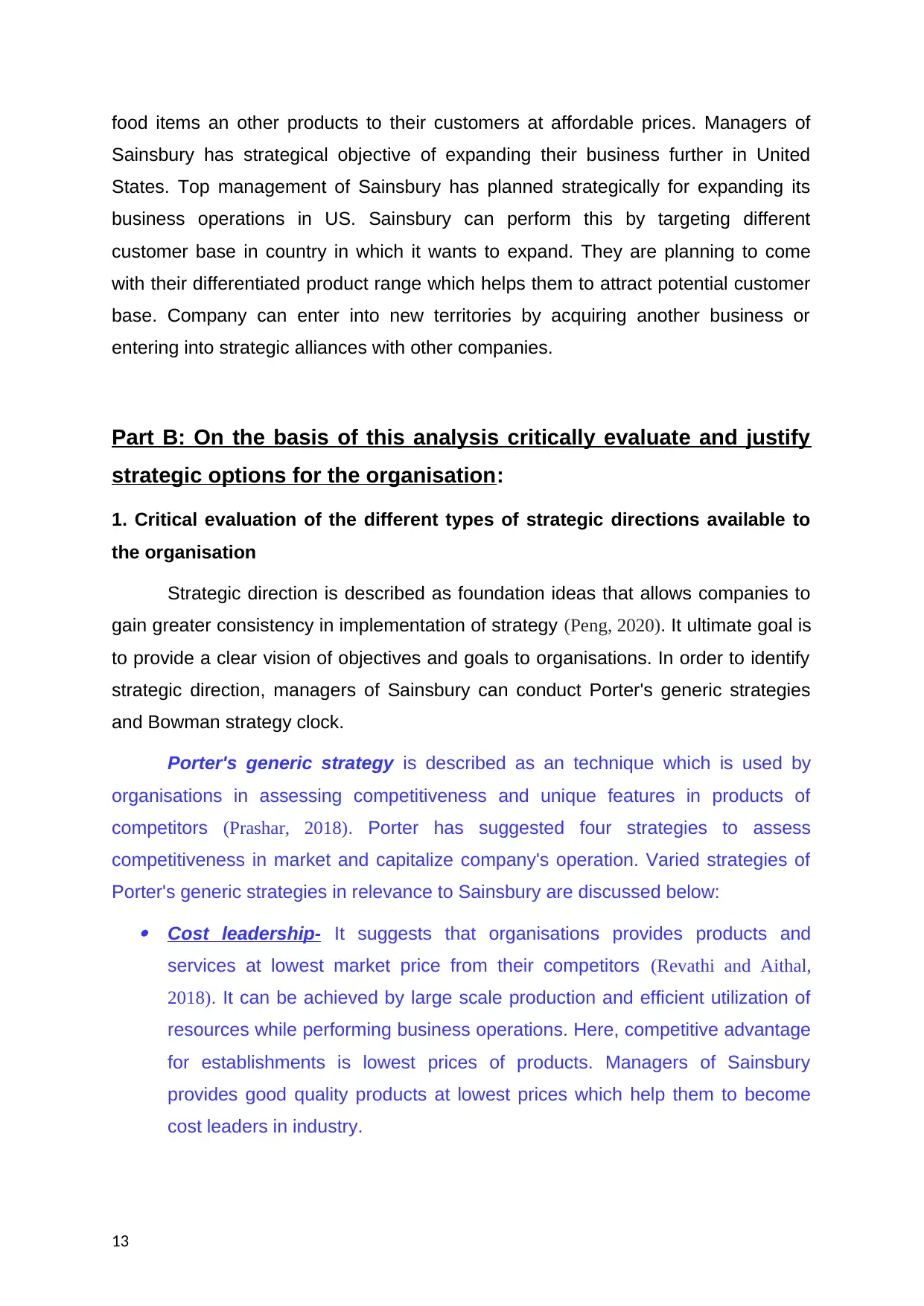
food items an other products to their customers at affordable prices. Managers of
Sainsbury has strategical objective of expanding their business further in United
States. Top management of Sainsbury has planned strategically for expanding its
business operations in US. Sainsbury can perform this by targeting different
customer base in country in which it wants to expand. They are planning to come
with their differentiated product range which helps them to attract potential customer
base. Company can enter into new territories by acquiring another business or
entering into strategic alliances with other companies.
Part B: On the basis of this analysis critically evaluate and justify
strategic options for the organisation:
1. Critical evaluation of the different types of strategic directions available to
the organisation
Strategic direction is described as foundation ideas that allows companies to
gain greater consistency in implementation of strategy (Peng, 2020). It ultimate goal is
to provide a clear vision of objectives and goals to organisations. In order to identify
strategic direction, managers of Sainsbury can conduct Porter's generic strategies
and Bowman strategy clock.
Porter's generic strategy is described as an technique which is used by
organisations in assessing competitiveness and unique features in products of
competitors (Prashar, 2018). Porter has suggested four strategies to assess
competitiveness in market and capitalize company's operation. Varied strategies of
Porter's generic strategies in relevance to Sainsbury are discussed below: Cost leadership- It suggests that organisations provides products and
services at lowest market price from their competitors (Revathi and Aithal,
2018). It can be achieved by large scale production and efficient utilization of
resources while performing business operations. Here, competitive advantage
for establishments is lowest prices of products. Managers of Sainsbury
provides good quality products at lowest prices which help them to become
cost leaders in industry.
13
Sainsbury has strategical objective of expanding their business further in United
States. Top management of Sainsbury has planned strategically for expanding its
business operations in US. Sainsbury can perform this by targeting different
customer base in country in which it wants to expand. They are planning to come
with their differentiated product range which helps them to attract potential customer
base. Company can enter into new territories by acquiring another business or
entering into strategic alliances with other companies.
Part B: On the basis of this analysis critically evaluate and justify
strategic options for the organisation:
1. Critical evaluation of the different types of strategic directions available to
the organisation
Strategic direction is described as foundation ideas that allows companies to
gain greater consistency in implementation of strategy (Peng, 2020). It ultimate goal is
to provide a clear vision of objectives and goals to organisations. In order to identify
strategic direction, managers of Sainsbury can conduct Porter's generic strategies
and Bowman strategy clock.
Porter's generic strategy is described as an technique which is used by
organisations in assessing competitiveness and unique features in products of
competitors (Prashar, 2018). Porter has suggested four strategies to assess
competitiveness in market and capitalize company's operation. Varied strategies of
Porter's generic strategies in relevance to Sainsbury are discussed below: Cost leadership- It suggests that organisations provides products and
services at lowest market price from their competitors (Revathi and Aithal,
2018). It can be achieved by large scale production and efficient utilization of
resources while performing business operations. Here, competitive advantage
for establishments is lowest prices of products. Managers of Sainsbury
provides good quality products at lowest prices which help them to become
cost leaders in industry.
13
Paraphrase This Document
Need a fresh take? Get an instant paraphrase of this document with our AI Paraphraser
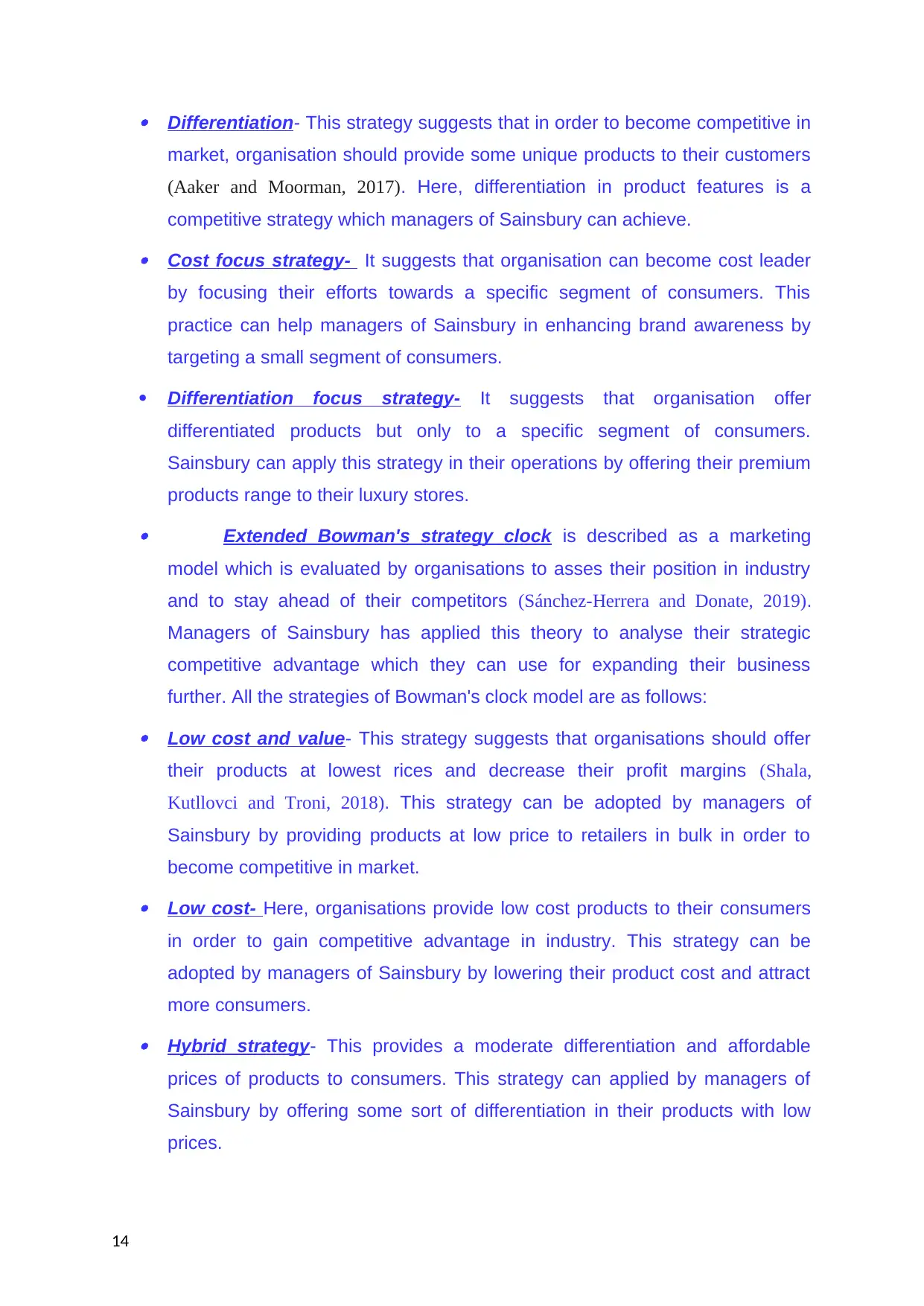
Differentiation- This strategy suggests that in order to become competitive in
market, organisation should provide some unique products to their customers
(Aaker and Moorman, 2017). Here, differentiation in product features is a
competitive strategy which managers of Sainsbury can achieve. Cost focus strategy- It suggests that organisation can become cost leader
by focusing their efforts towards a specific segment of consumers. This
practice can help managers of Sainsbury in enhancing brand awareness by
targeting a small segment of consumers.
Differentiation focus strategy- It suggests that organisation offer
differentiated products but only to a specific segment of consumers.
Sainsbury can apply this strategy in their operations by offering their premium
products range to their luxury stores. Extended Bowman's strategy clock is described as a marketing
model which is evaluated by organisations to asses their position in industry
and to stay ahead of their competitors (Sánchez-Herrera and Donate, 2019).
Managers of Sainsbury has applied this theory to analyse their strategic
competitive advantage which they can use for expanding their business
further. All the strategies of Bowman's clock model are as follows: Low cost and value- This strategy suggests that organisations should offer
their products at lowest rices and decrease their profit margins (Shala,
Kutllovci and Troni, 2018). This strategy can be adopted by managers of
Sainsbury by providing products at low price to retailers in bulk in order to
become competitive in market. Low cost- Here, organisations provide low cost products to their consumers
in order to gain competitive advantage in industry. This strategy can be
adopted by managers of Sainsbury by lowering their product cost and attract
more consumers. Hybrid strategy- This provides a moderate differentiation and affordable
prices of products to consumers. This strategy can applied by managers of
Sainsbury by offering some sort of differentiation in their products with low
prices.
14
market, organisation should provide some unique products to their customers
(Aaker and Moorman, 2017). Here, differentiation in product features is a
competitive strategy which managers of Sainsbury can achieve. Cost focus strategy- It suggests that organisation can become cost leader
by focusing their efforts towards a specific segment of consumers. This
practice can help managers of Sainsbury in enhancing brand awareness by
targeting a small segment of consumers.
Differentiation focus strategy- It suggests that organisation offer
differentiated products but only to a specific segment of consumers.
Sainsbury can apply this strategy in their operations by offering their premium
products range to their luxury stores. Extended Bowman's strategy clock is described as a marketing
model which is evaluated by organisations to asses their position in industry
and to stay ahead of their competitors (Sánchez-Herrera and Donate, 2019).
Managers of Sainsbury has applied this theory to analyse their strategic
competitive advantage which they can use for expanding their business
further. All the strategies of Bowman's clock model are as follows: Low cost and value- This strategy suggests that organisations should offer
their products at lowest rices and decrease their profit margins (Shala,
Kutllovci and Troni, 2018). This strategy can be adopted by managers of
Sainsbury by providing products at low price to retailers in bulk in order to
become competitive in market. Low cost- Here, organisations provide low cost products to their consumers
in order to gain competitive advantage in industry. This strategy can be
adopted by managers of Sainsbury by lowering their product cost and attract
more consumers. Hybrid strategy- This provides a moderate differentiation and affordable
prices of products to consumers. This strategy can applied by managers of
Sainsbury by offering some sort of differentiation in their products with low
prices.
14
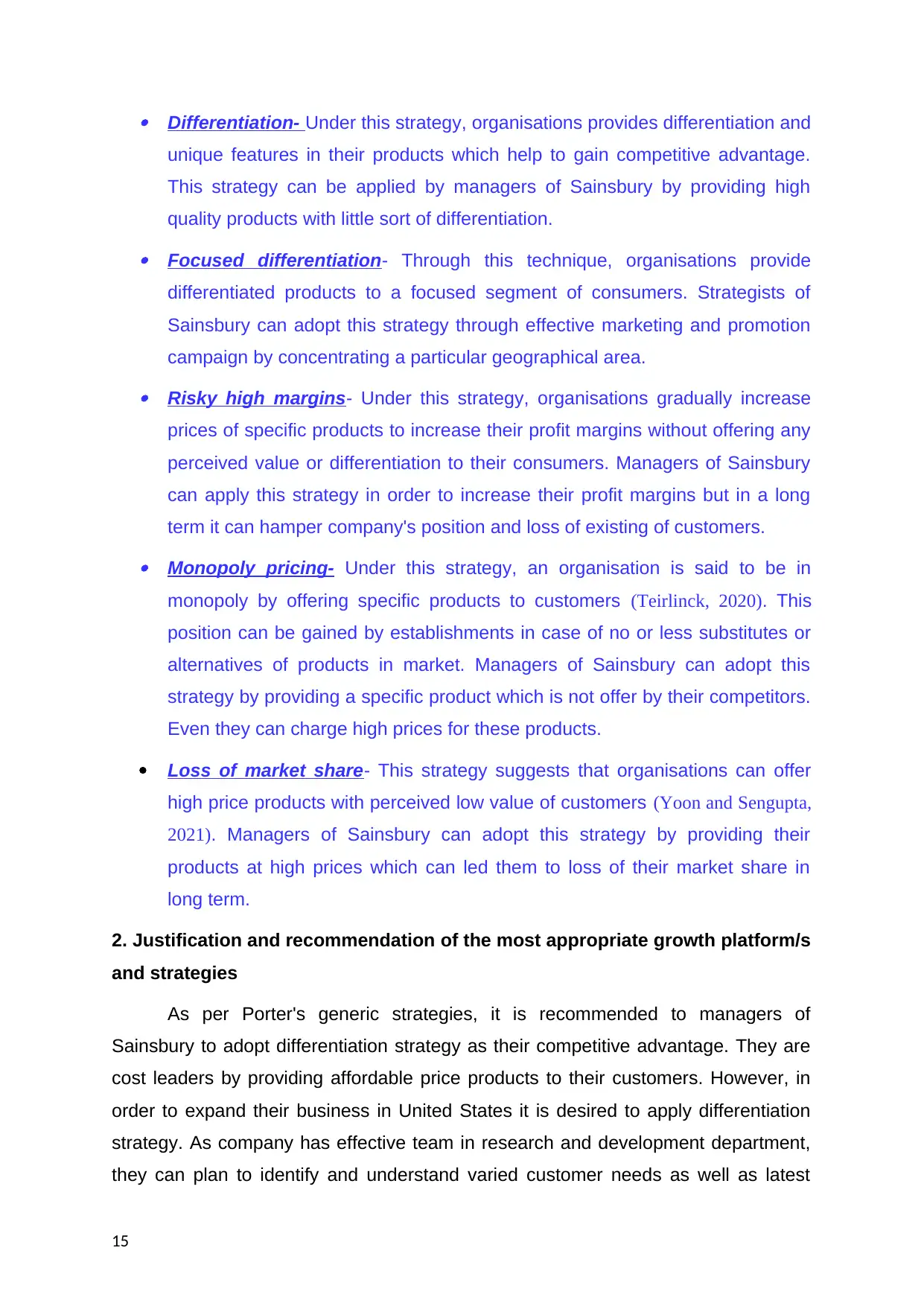
Differentiation- Under this strategy, organisations provides differentiation and
unique features in their products which help to gain competitive advantage.
This strategy can be applied by managers of Sainsbury by providing high
quality products with little sort of differentiation. Focused differentiation- Through this technique, organisations provide
differentiated products to a focused segment of consumers. Strategists of
Sainsbury can adopt this strategy through effective marketing and promotion
campaign by concentrating a particular geographical area. Risky high margins- Under this strategy, organisations gradually increase
prices of specific products to increase their profit margins without offering any
perceived value or differentiation to their consumers. Managers of Sainsbury
can apply this strategy in order to increase their profit margins but in a long
term it can hamper company's position and loss of existing of customers. Monopoly pricing- Under this strategy, an organisation is said to be in
monopoly by offering specific products to customers (Teirlinck, 2020). This
position can be gained by establishments in case of no or less substitutes or
alternatives of products in market. Managers of Sainsbury can adopt this
strategy by providing a specific product which is not offer by their competitors.
Even they can charge high prices for these products.
Loss of market share- This strategy suggests that organisations can offer
high price products with perceived low value of customers (Yoon and Sengupta,
2021). Managers of Sainsbury can adopt this strategy by providing their
products at high prices which can led them to loss of their market share in
long term.
2. Justification and recommendation of the most appropriate growth platform/s
and strategies
As per Porter's generic strategies, it is recommended to managers of
Sainsbury to adopt differentiation strategy as their competitive advantage. They are
cost leaders by providing affordable price products to their customers. However, in
order to expand their business in United States it is desired to apply differentiation
strategy. As company has effective team in research and development department,
they can plan to identify and understand varied customer needs as well as latest
15
unique features in their products which help to gain competitive advantage.
This strategy can be applied by managers of Sainsbury by providing high
quality products with little sort of differentiation. Focused differentiation- Through this technique, organisations provide
differentiated products to a focused segment of consumers. Strategists of
Sainsbury can adopt this strategy through effective marketing and promotion
campaign by concentrating a particular geographical area. Risky high margins- Under this strategy, organisations gradually increase
prices of specific products to increase their profit margins without offering any
perceived value or differentiation to their consumers. Managers of Sainsbury
can apply this strategy in order to increase their profit margins but in a long
term it can hamper company's position and loss of existing of customers. Monopoly pricing- Under this strategy, an organisation is said to be in
monopoly by offering specific products to customers (Teirlinck, 2020). This
position can be gained by establishments in case of no or less substitutes or
alternatives of products in market. Managers of Sainsbury can adopt this
strategy by providing a specific product which is not offer by their competitors.
Even they can charge high prices for these products.
Loss of market share- This strategy suggests that organisations can offer
high price products with perceived low value of customers (Yoon and Sengupta,
2021). Managers of Sainsbury can adopt this strategy by providing their
products at high prices which can led them to loss of their market share in
long term.
2. Justification and recommendation of the most appropriate growth platform/s
and strategies
As per Porter's generic strategies, it is recommended to managers of
Sainsbury to adopt differentiation strategy as their competitive advantage. They are
cost leaders by providing affordable price products to their customers. However, in
order to expand their business in United States it is desired to apply differentiation
strategy. As company has effective team in research and development department,
they can plan to identify and understand varied customer needs as well as latest
15
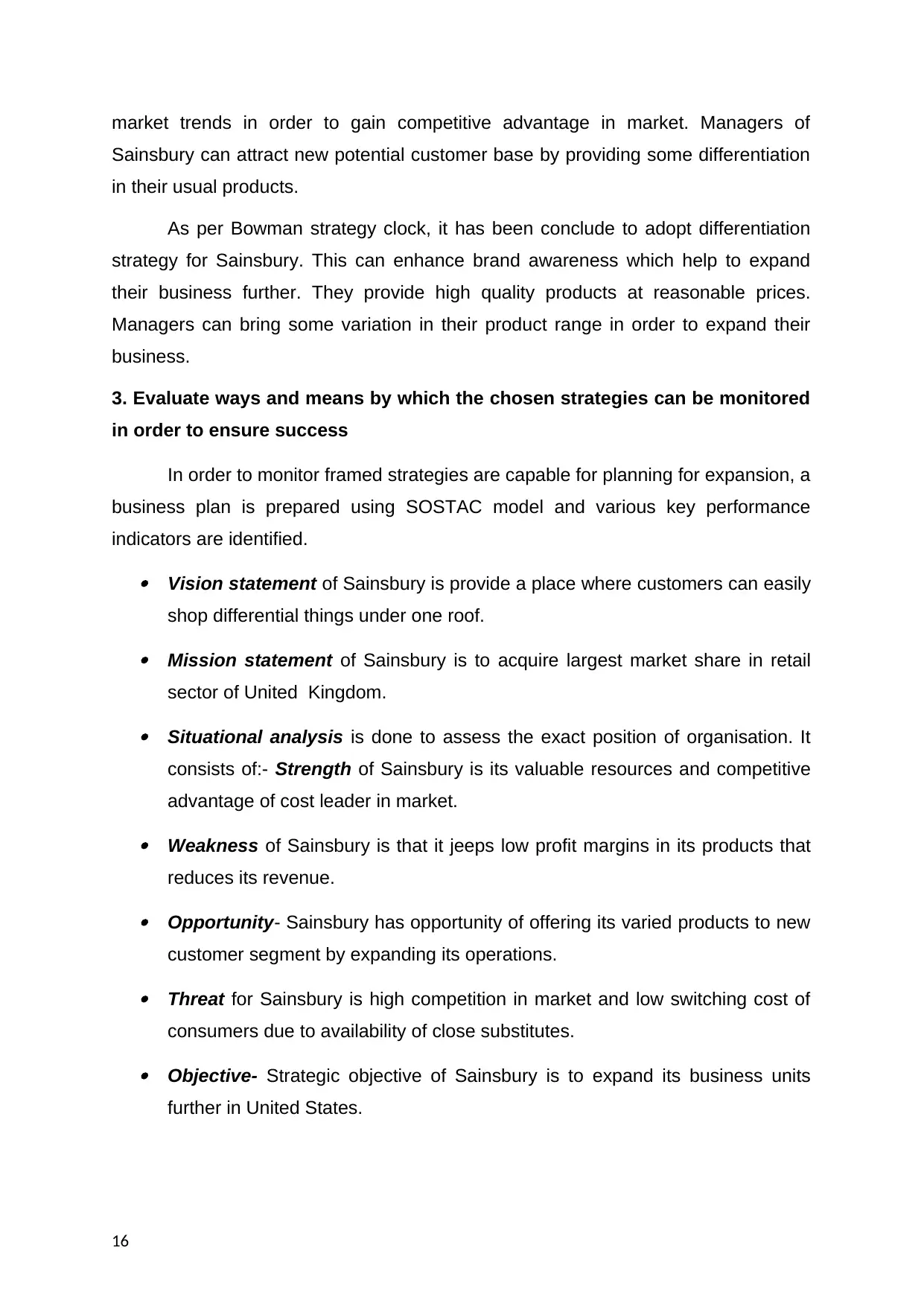
market trends in order to gain competitive advantage in market. Managers of
Sainsbury can attract new potential customer base by providing some differentiation
in their usual products.
As per Bowman strategy clock, it has been conclude to adopt differentiation
strategy for Sainsbury. This can enhance brand awareness which help to expand
their business further. They provide high quality products at reasonable prices.
Managers can bring some variation in their product range in order to expand their
business.
3. Evaluate ways and means by which the chosen strategies can be monitored
in order to ensure success
In order to monitor framed strategies are capable for planning for expansion, a
business plan is prepared using SOSTAC model and various key performance
indicators are identified. Vision statement of Sainsbury is provide a place where customers can easily
shop differential things under one roof. Mission statement of Sainsbury is to acquire largest market share in retail
sector of United Kingdom. Situational analysis is done to assess the exact position of organisation. It
consists of:- Strength of Sainsbury is its valuable resources and competitive
advantage of cost leader in market. Weakness of Sainsbury is that it jeeps low profit margins in its products that
reduces its revenue. Opportunity- Sainsbury has opportunity of offering its varied products to new
customer segment by expanding its operations. Threat for Sainsbury is high competition in market and low switching cost of
consumers due to availability of close substitutes. Objective- Strategic objective of Sainsbury is to expand its business units
further in United States.
16
Sainsbury can attract new potential customer base by providing some differentiation
in their usual products.
As per Bowman strategy clock, it has been conclude to adopt differentiation
strategy for Sainsbury. This can enhance brand awareness which help to expand
their business further. They provide high quality products at reasonable prices.
Managers can bring some variation in their product range in order to expand their
business.
3. Evaluate ways and means by which the chosen strategies can be monitored
in order to ensure success
In order to monitor framed strategies are capable for planning for expansion, a
business plan is prepared using SOSTAC model and various key performance
indicators are identified. Vision statement of Sainsbury is provide a place where customers can easily
shop differential things under one roof. Mission statement of Sainsbury is to acquire largest market share in retail
sector of United Kingdom. Situational analysis is done to assess the exact position of organisation. It
consists of:- Strength of Sainsbury is its valuable resources and competitive
advantage of cost leader in market. Weakness of Sainsbury is that it jeeps low profit margins in its products that
reduces its revenue. Opportunity- Sainsbury has opportunity of offering its varied products to new
customer segment by expanding its operations. Threat for Sainsbury is high competition in market and low switching cost of
consumers due to availability of close substitutes. Objective- Strategic objective of Sainsbury is to expand its business units
further in United States.
16
Secure Best Marks with AI Grader
Need help grading? Try our AI Grader for instant feedback on your assignments.
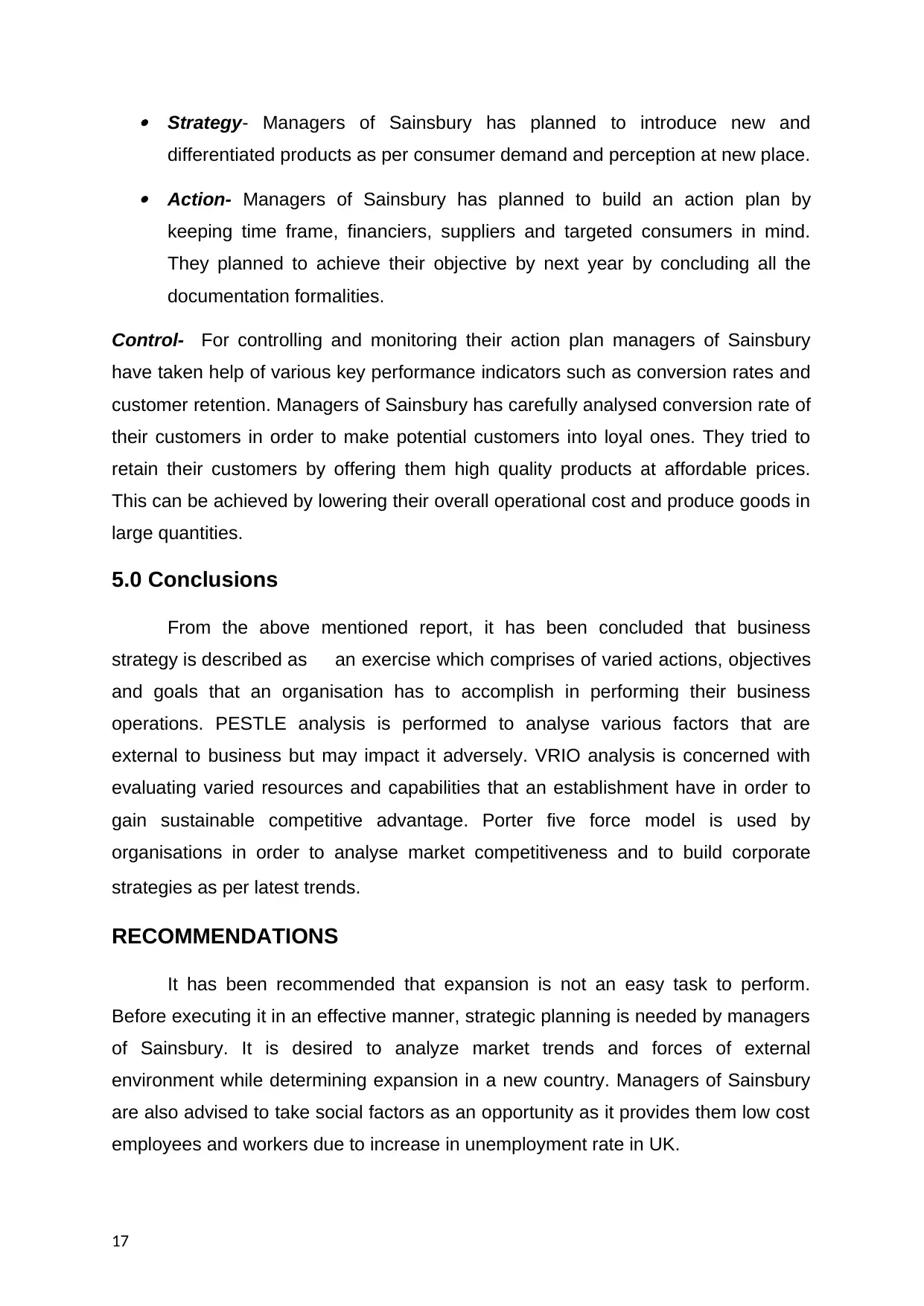
Strategy- Managers of Sainsbury has planned to introduce new and
differentiated products as per consumer demand and perception at new place. Action- Managers of Sainsbury has planned to build an action plan by
keeping time frame, financiers, suppliers and targeted consumers in mind.
They planned to achieve their objective by next year by concluding all the
documentation formalities.
Control- For controlling and monitoring their action plan managers of Sainsbury
have taken help of various key performance indicators such as conversion rates and
customer retention. Managers of Sainsbury has carefully analysed conversion rate of
their customers in order to make potential customers into loyal ones. They tried to
retain their customers by offering them high quality products at affordable prices.
This can be achieved by lowering their overall operational cost and produce goods in
large quantities.
5.0 Conclusions
From the above mentioned report, it has been concluded that business
strategy is described as an exercise which comprises of varied actions, objectives
and goals that an organisation has to accomplish in performing their business
operations. PESTLE analysis is performed to analyse various factors that are
external to business but may impact it adversely. VRIO analysis is concerned with
evaluating varied resources and capabilities that an establishment have in order to
gain sustainable competitive advantage. Porter five force model is used by
organisations in order to analyse market competitiveness and to build corporate
strategies as per latest trends.
RECOMMENDATIONS
It has been recommended that expansion is not an easy task to perform.
Before executing it in an effective manner, strategic planning is needed by managers
of Sainsbury. It is desired to analyze market trends and forces of external
environment while determining expansion in a new country. Managers of Sainsbury
are also advised to take social factors as an opportunity as it provides them low cost
employees and workers due to increase in unemployment rate in UK.
17
differentiated products as per consumer demand and perception at new place. Action- Managers of Sainsbury has planned to build an action plan by
keeping time frame, financiers, suppliers and targeted consumers in mind.
They planned to achieve their objective by next year by concluding all the
documentation formalities.
Control- For controlling and monitoring their action plan managers of Sainsbury
have taken help of various key performance indicators such as conversion rates and
customer retention. Managers of Sainsbury has carefully analysed conversion rate of
their customers in order to make potential customers into loyal ones. They tried to
retain their customers by offering them high quality products at affordable prices.
This can be achieved by lowering their overall operational cost and produce goods in
large quantities.
5.0 Conclusions
From the above mentioned report, it has been concluded that business
strategy is described as an exercise which comprises of varied actions, objectives
and goals that an organisation has to accomplish in performing their business
operations. PESTLE analysis is performed to analyse various factors that are
external to business but may impact it adversely. VRIO analysis is concerned with
evaluating varied resources and capabilities that an establishment have in order to
gain sustainable competitive advantage. Porter five force model is used by
organisations in order to analyse market competitiveness and to build corporate
strategies as per latest trends.
RECOMMENDATIONS
It has been recommended that expansion is not an easy task to perform.
Before executing it in an effective manner, strategic planning is needed by managers
of Sainsbury. It is desired to analyze market trends and forces of external
environment while determining expansion in a new country. Managers of Sainsbury
are also advised to take social factors as an opportunity as it provides them low cost
employees and workers due to increase in unemployment rate in UK.
17
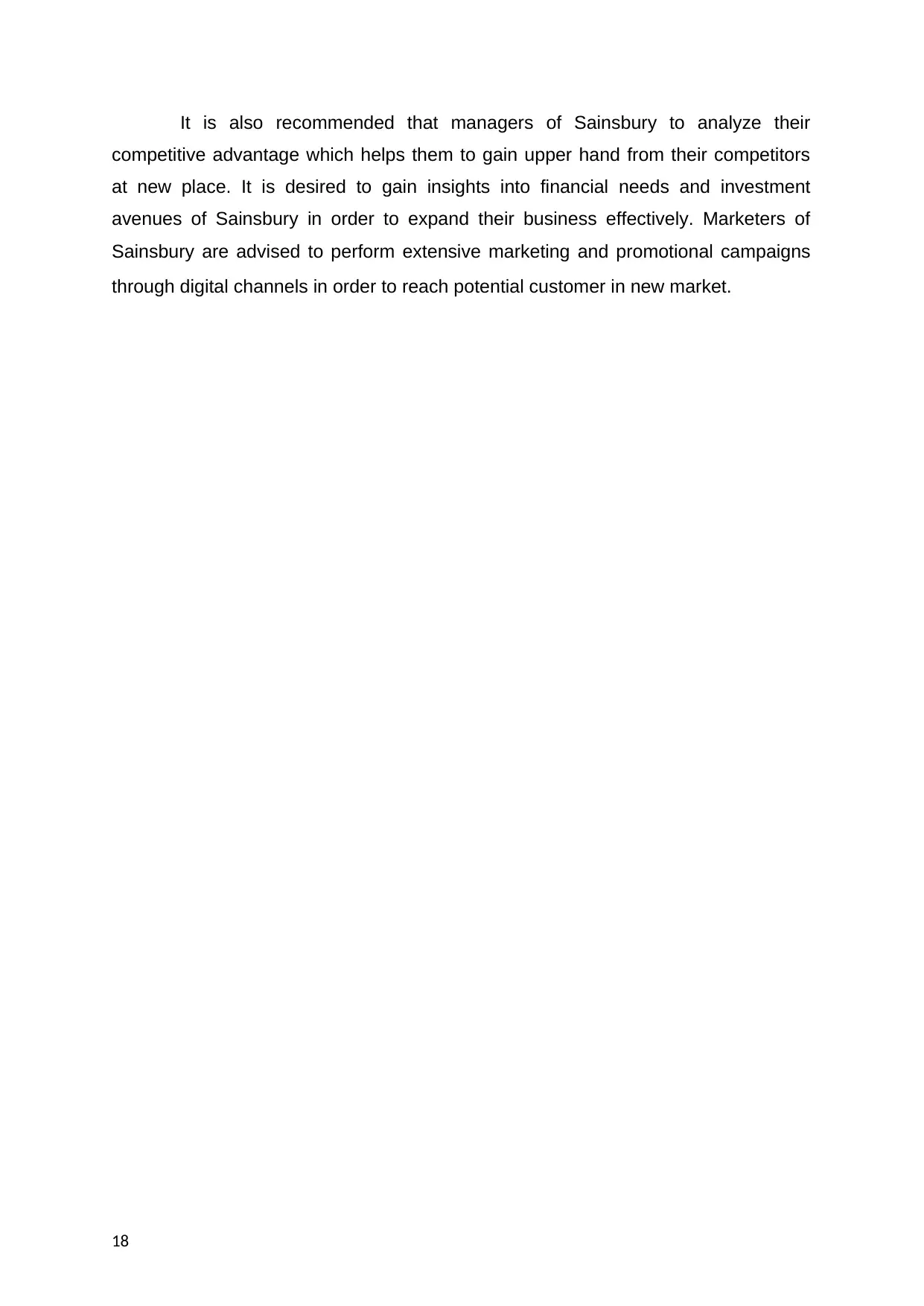
It is also recommended that managers of Sainsbury to analyze their
competitive advantage which helps them to gain upper hand from their competitors
at new place. It is desired to gain insights into financial needs and investment
avenues of Sainsbury in order to expand their business effectively. Marketers of
Sainsbury are advised to perform extensive marketing and promotional campaigns
through digital channels in order to reach potential customer in new market.
18
competitive advantage which helps them to gain upper hand from their competitors
at new place. It is desired to gain insights into financial needs and investment
avenues of Sainsbury in order to expand their business effectively. Marketers of
Sainsbury are advised to perform extensive marketing and promotional campaigns
through digital channels in order to reach potential customer in new market.
18
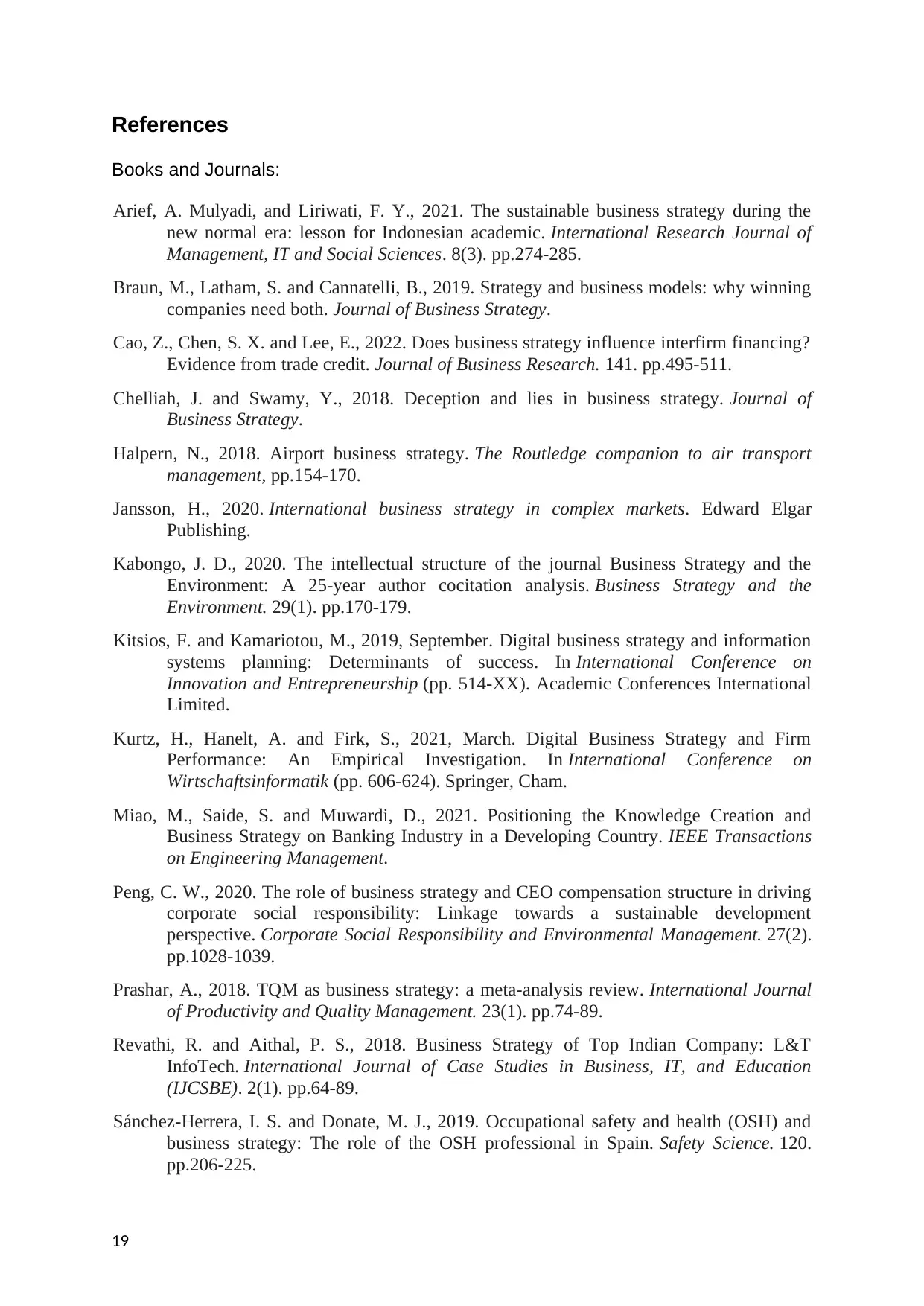
References
Books and Journals:
Arief, A. Mulyadi, and Liriwati, F. Y., 2021. The sustainable business strategy during the
new normal era: lesson for Indonesian academic. International Research Journal of
Management, IT and Social Sciences. 8(3). pp.274-285.
Braun, M., Latham, S. and Cannatelli, B., 2019. Strategy and business models: why winning
companies need both. Journal of Business Strategy.
Cao, Z., Chen, S. X. and Lee, E., 2022. Does business strategy influence interfirm financing?
Evidence from trade credit. Journal of Business Research. 141. pp.495-511.
Chelliah, J. and Swamy, Y., 2018. Deception and lies in business strategy. Journal of
Business Strategy.
Halpern, N., 2018. Airport business strategy. The Routledge companion to air transport
management, pp.154-170.
Jansson, H., 2020. International business strategy in complex markets. Edward Elgar
Publishing.
Kabongo, J. D., 2020. The intellectual structure of the journal Business Strategy and the
Environment: A 25‐year author cocitation analysis. Business Strategy and the
Environment. 29(1). pp.170-179.
Kitsios, F. and Kamariotou, M., 2019, September. Digital business strategy and information
systems planning: Determinants of success. In International Conference on
Innovation and Entrepreneurship (pp. 514-XX). Academic Conferences International
Limited.
Kurtz, H., Hanelt, A. and Firk, S., 2021, March. Digital Business Strategy and Firm
Performance: An Empirical Investigation. In International Conference on
Wirtschaftsinformatik (pp. 606-624). Springer, Cham.
Miao, M., Saide, S. and Muwardi, D., 2021. Positioning the Knowledge Creation and
Business Strategy on Banking Industry in a Developing Country. IEEE Transactions
on Engineering Management.
Peng, C. W., 2020. The role of business strategy and CEO compensation structure in driving
corporate social responsibility: Linkage towards a sustainable development
perspective. Corporate Social Responsibility and Environmental Management. 27(2).
pp.1028-1039.
Prashar, A., 2018. TQM as business strategy: a meta-analysis review. International Journal
of Productivity and Quality Management. 23(1). pp.74-89.
Revathi, R. and Aithal, P. S., 2018. Business Strategy of Top Indian Company: L&T
InfoTech. International Journal of Case Studies in Business, IT, and Education
(IJCSBE). 2(1). pp.64-89.
Sánchez-Herrera, I. S. and Donate, M. J., 2019. Occupational safety and health (OSH) and
business strategy: The role of the OSH professional in Spain. Safety Science. 120.
pp.206-225.
19
Books and Journals:
Arief, A. Mulyadi, and Liriwati, F. Y., 2021. The sustainable business strategy during the
new normal era: lesson for Indonesian academic. International Research Journal of
Management, IT and Social Sciences. 8(3). pp.274-285.
Braun, M., Latham, S. and Cannatelli, B., 2019. Strategy and business models: why winning
companies need both. Journal of Business Strategy.
Cao, Z., Chen, S. X. and Lee, E., 2022. Does business strategy influence interfirm financing?
Evidence from trade credit. Journal of Business Research. 141. pp.495-511.
Chelliah, J. and Swamy, Y., 2018. Deception and lies in business strategy. Journal of
Business Strategy.
Halpern, N., 2018. Airport business strategy. The Routledge companion to air transport
management, pp.154-170.
Jansson, H., 2020. International business strategy in complex markets. Edward Elgar
Publishing.
Kabongo, J. D., 2020. The intellectual structure of the journal Business Strategy and the
Environment: A 25‐year author cocitation analysis. Business Strategy and the
Environment. 29(1). pp.170-179.
Kitsios, F. and Kamariotou, M., 2019, September. Digital business strategy and information
systems planning: Determinants of success. In International Conference on
Innovation and Entrepreneurship (pp. 514-XX). Academic Conferences International
Limited.
Kurtz, H., Hanelt, A. and Firk, S., 2021, March. Digital Business Strategy and Firm
Performance: An Empirical Investigation. In International Conference on
Wirtschaftsinformatik (pp. 606-624). Springer, Cham.
Miao, M., Saide, S. and Muwardi, D., 2021. Positioning the Knowledge Creation and
Business Strategy on Banking Industry in a Developing Country. IEEE Transactions
on Engineering Management.
Peng, C. W., 2020. The role of business strategy and CEO compensation structure in driving
corporate social responsibility: Linkage towards a sustainable development
perspective. Corporate Social Responsibility and Environmental Management. 27(2).
pp.1028-1039.
Prashar, A., 2018. TQM as business strategy: a meta-analysis review. International Journal
of Productivity and Quality Management. 23(1). pp.74-89.
Revathi, R. and Aithal, P. S., 2018. Business Strategy of Top Indian Company: L&T
InfoTech. International Journal of Case Studies in Business, IT, and Education
(IJCSBE). 2(1). pp.64-89.
Sánchez-Herrera, I. S. and Donate, M. J., 2019. Occupational safety and health (OSH) and
business strategy: The role of the OSH professional in Spain. Safety Science. 120.
pp.206-225.
19
Paraphrase This Document
Need a fresh take? Get an instant paraphrase of this document with our AI Paraphraser
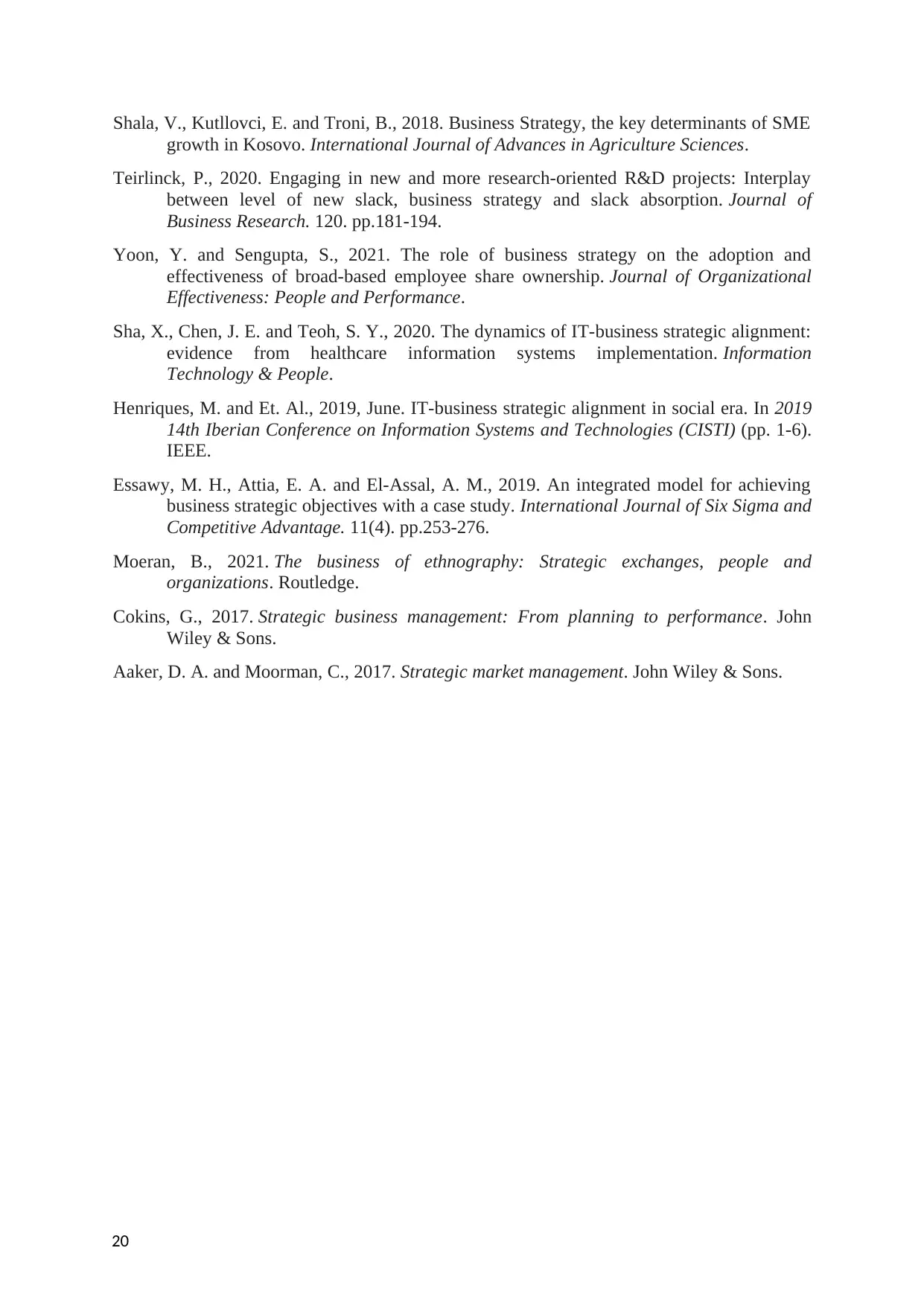
Shala, V., Kutllovci, E. and Troni, B., 2018. Business Strategy, the key determinants of SME
growth in Kosovo. International Journal of Advances in Agriculture Sciences.
Teirlinck, P., 2020. Engaging in new and more research-oriented R&D projects: Interplay
between level of new slack, business strategy and slack absorption. Journal of
Business Research. 120. pp.181-194.
Yoon, Y. and Sengupta, S., 2021. The role of business strategy on the adoption and
effectiveness of broad-based employee share ownership. Journal of Organizational
Effectiveness: People and Performance.
Sha, X., Chen, J. E. and Teoh, S. Y., 2020. The dynamics of IT-business strategic alignment:
evidence from healthcare information systems implementation. Information
Technology & People.
Henriques, M. and Et. Al., 2019, June. IT-business strategic alignment in social era. In 2019
14th Iberian Conference on Information Systems and Technologies (CISTI) (pp. 1-6).
IEEE.
Essawy, M. H., Attia, E. A. and El-Assal, A. M., 2019. An integrated model for achieving
business strategic objectives with a case study. International Journal of Six Sigma and
Competitive Advantage. 11(4). pp.253-276.
Moeran, B., 2021. The business of ethnography: Strategic exchanges, people and
organizations. Routledge.
Cokins, G., 2017. Strategic business management: From planning to performance. John
Wiley & Sons.
Aaker, D. A. and Moorman, C., 2017. Strategic market management. John Wiley & Sons.
20
growth in Kosovo. International Journal of Advances in Agriculture Sciences.
Teirlinck, P., 2020. Engaging in new and more research-oriented R&D projects: Interplay
between level of new slack, business strategy and slack absorption. Journal of
Business Research. 120. pp.181-194.
Yoon, Y. and Sengupta, S., 2021. The role of business strategy on the adoption and
effectiveness of broad-based employee share ownership. Journal of Organizational
Effectiveness: People and Performance.
Sha, X., Chen, J. E. and Teoh, S. Y., 2020. The dynamics of IT-business strategic alignment:
evidence from healthcare information systems implementation. Information
Technology & People.
Henriques, M. and Et. Al., 2019, June. IT-business strategic alignment in social era. In 2019
14th Iberian Conference on Information Systems and Technologies (CISTI) (pp. 1-6).
IEEE.
Essawy, M. H., Attia, E. A. and El-Assal, A. M., 2019. An integrated model for achieving
business strategic objectives with a case study. International Journal of Six Sigma and
Competitive Advantage. 11(4). pp.253-276.
Moeran, B., 2021. The business of ethnography: Strategic exchanges, people and
organizations. Routledge.
Cokins, G., 2017. Strategic business management: From planning to performance. John
Wiley & Sons.
Aaker, D. A. and Moorman, C., 2017. Strategic market management. John Wiley & Sons.
20

21
1 out of 21
Related Documents
Your All-in-One AI-Powered Toolkit for Academic Success.
+13062052269
info@desklib.com
Available 24*7 on WhatsApp / Email
![[object Object]](/_next/static/media/star-bottom.7253800d.svg)
Unlock your academic potential
© 2024 | Zucol Services PVT LTD | All rights reserved.



